Archive for the ‘Mount Kōya’ Tag
Sunday, August 6: After walking through the mystical Okunoin, I stop to check in at Kumagaiji, the temple lodging, or shukubō, where I plan to spend the night. I don’t linger, since I have plenty of time this evening to explore the temple, but instead head out to finish exploring Kōyasan, making my first stop at Kongōbu-ji Temple.
In the year 804, Kobo Daishi (Kukai) crossed the sea to China to seek out Buddhist teachings. In the capital of Tang Dynasty China, he found a lineage of Buddhism, Shingon Buddhist, relatively unknown in Japan. Returning to Japan in 806, he began teaching. In 816, he was granted permission from the Imperial Court to build a monastic complex at Mt. Kōya, isolated from the distractions of the capital. Kobo Daishi lived and taught in Mt. Kōya for many years until he finally entered into eternal meditation in 835. Pilgrims flock to his mausoleum at Mt. Kōya in great numbers every year. He is believed to give aid and comfort to the millions of people who pray to him in their homes, local temples and at Okunoin.
The original temple was built in 1593 to memorialize Toyotomi Hideyoshi’s mother, some of whose hair was kept here. The temple was lost in fires two or three times and was rebuilt in 1863. Two temples, Kozanji Temple and Seiganji Temple, were combined in 1869 and renamed Kongōbu-ji Temple, meaning Temple of the Diamond Mountain Peak, to function as the headquarters of Kōyasan Shingon Buddhism. Kongōbu-ji is part of the “Sacred Sites and Pilgrimage Routes in the Kii Mountain Range” UNESCO World Heritage Site.
The gate is the oldest building at Kongōbu-ji and was constructed in 1593.

Kongobuji Temple
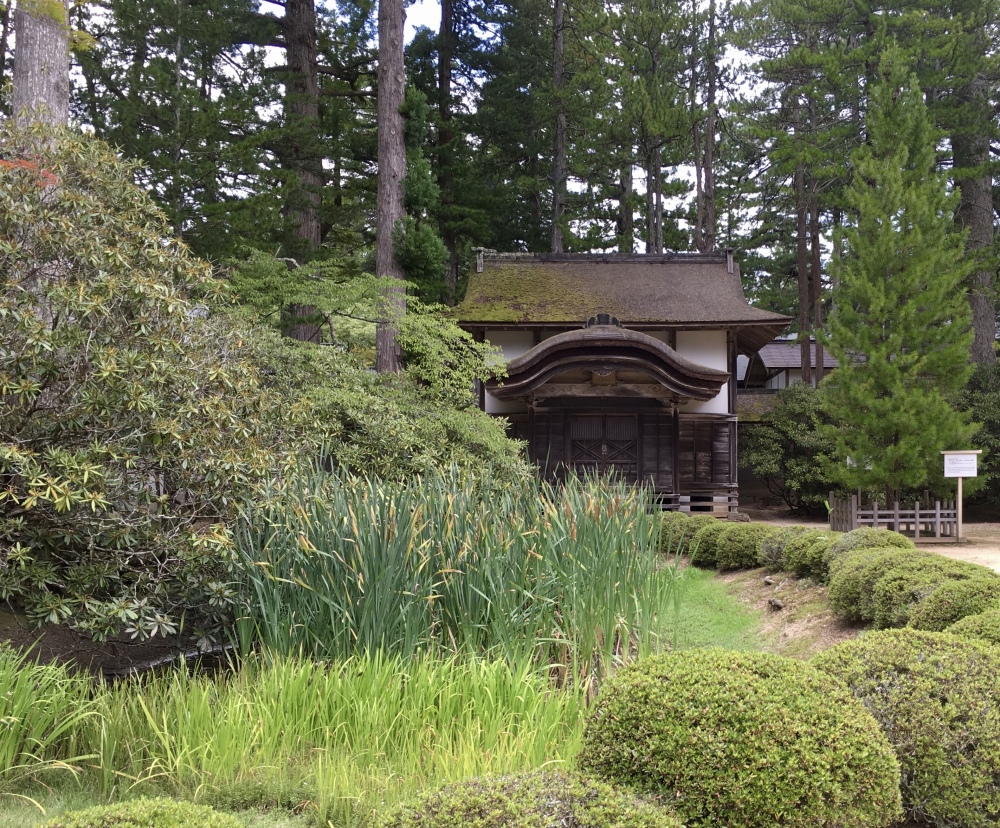
Kongobuji Temple
The Koya-maki (Japanese umbrella pine) was planted to celebrate the imperial visit of Emperor and Empress Showa on April 18, 1977. Koya-maki is the seal of Prince Hisahito.

Koya-maki (Japanese umbrella pine)

Koya-maki

Koya-maki at Kongobuji Temple

Kongobuji Temple

Kongobuji Temple

Kongobuji Temple
Kongōbu-ji Temple is centered around the Great Main Hall.

Kongobuji Temple
A Buddha Hall contains many sliding screen doors of cranes guessed to have been painted by Tashitsu Saito, who was active in the early Edo period.
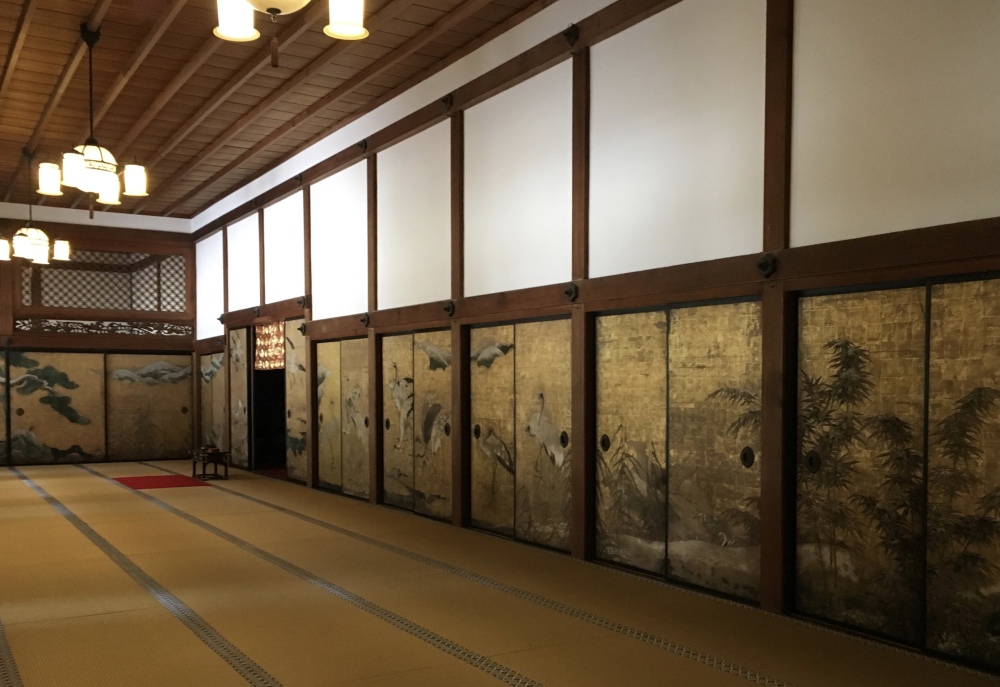
Ohiroma

Ohiroma
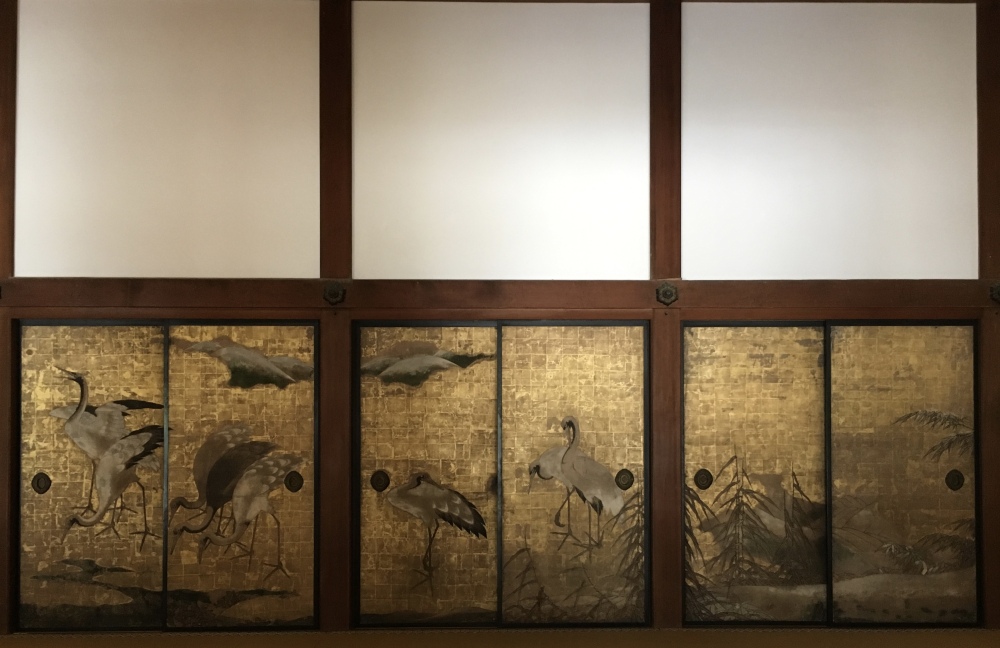
Ohiroma
Out on the porch are panels of Japanese characters but I’m not sure what they are.

panels of wishes?
The temple’s modern Banryūtei rock garden is the largest rock garden in Japan (2,349 meters). The design is of a pair of dragons emerging from a sea of clouds to protect the temple. The dragons are made of 140 pieces of granite brought from Shikoku while the white sand is from Kyoto.
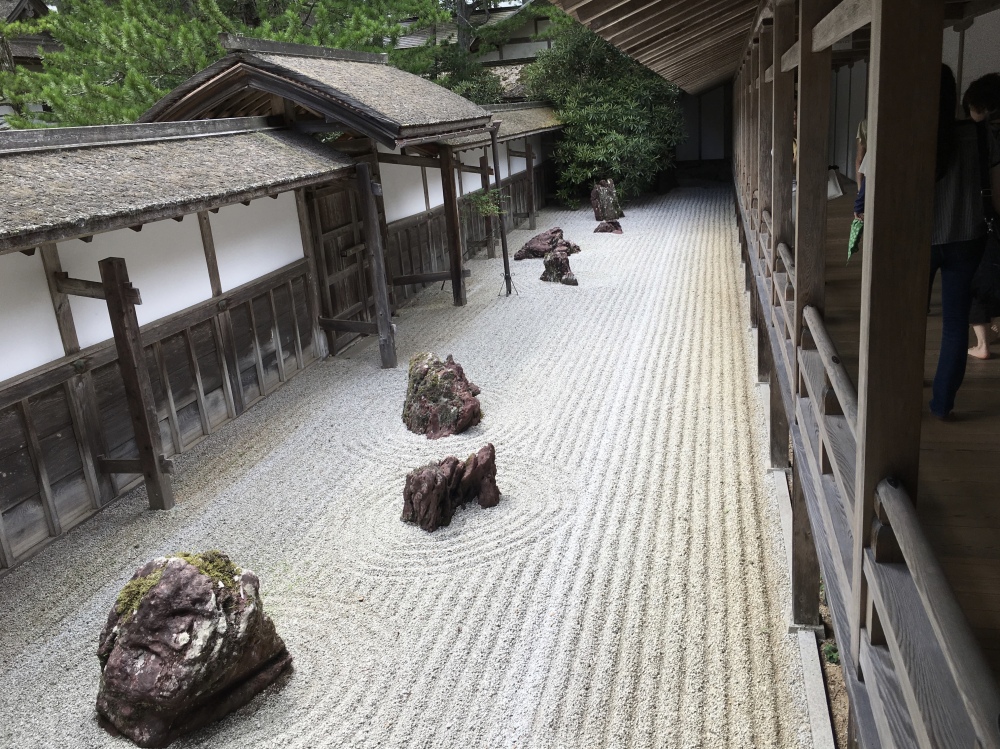
Banryūtei rock garden
I love looking at this amazing rock garden from every possible angle.

Banryūtei rock garden

Banryūtei rock garden
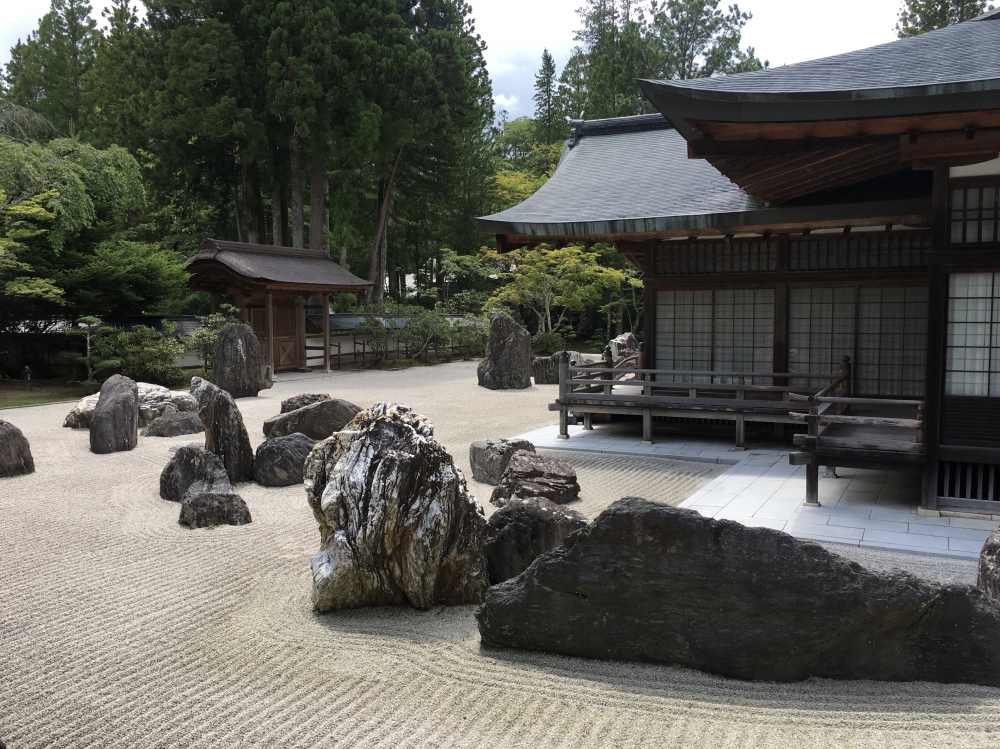
Banryūtei rock garden
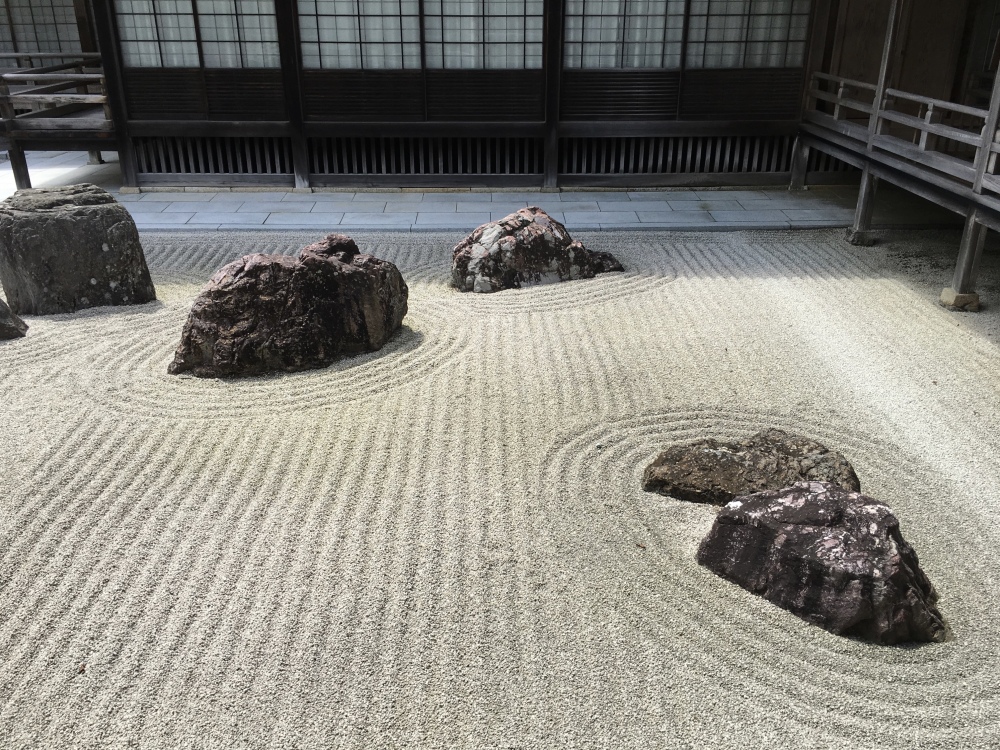
Banryūtei rock garden

Banryūtei rock garden

Banryūtei rock garden

Banryūtei rock garden

Banryūtei rock garden

Banryūtei rock garden

Banryūtei rock garden

Banryūtei rock garden
Inside, I find more panels of crane paintings.

painted panels

Kongobuiji Temple
Visitors can get a glimpse of the Mausoleum of Bishop Shinzen, originally built in 1640 to honor Shinzen, the disciple and successor of Kobo Daishi. He worked as a manager of Koyasan for 56 years. A small altar is set up in front, and the building is roofed in the traditional way with cypress bark. Repairs were completed in October, 1989 in preparation for the 1100th anniversary of Shinzen’s death. During the repairs, a relic container was discovered. The building was consequently renamed the Mausoleum of Shinzen and rededicated.

The Mausoleum of Bishop Shinzen
After leaving, I wander along the main road, passing once again past the beautiful grounds of Shojoshin-in, another shukubō.

Shojoshin-in

Shojoshin-in

Shojoshin-in
The garden of Hōzen-in Monastery was here in the early Momoyama Period (1573-1615). The stones are arranged to symbolize the landscape. The waterless waterfall is an unusual feature.

Hōzen-in Monastery
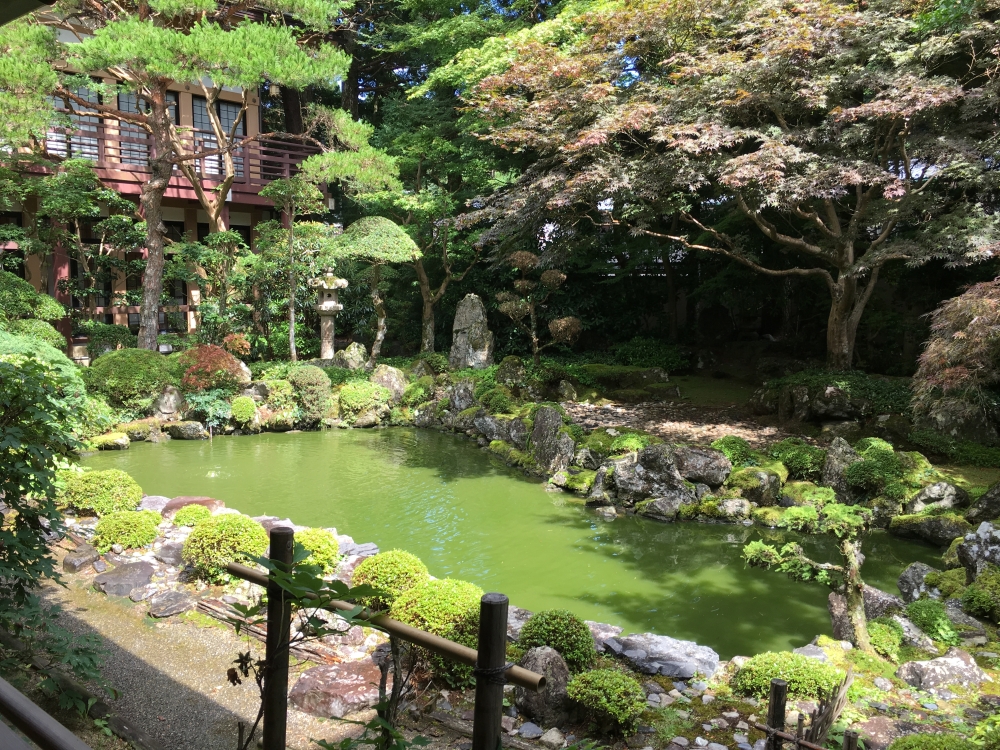
The garden of Hōzen-in Monastery

The garden of Hōzen-in Monastery

The garden of Hōzen-in Monastery
Ekōin is another temple lodging with pretty grounds.
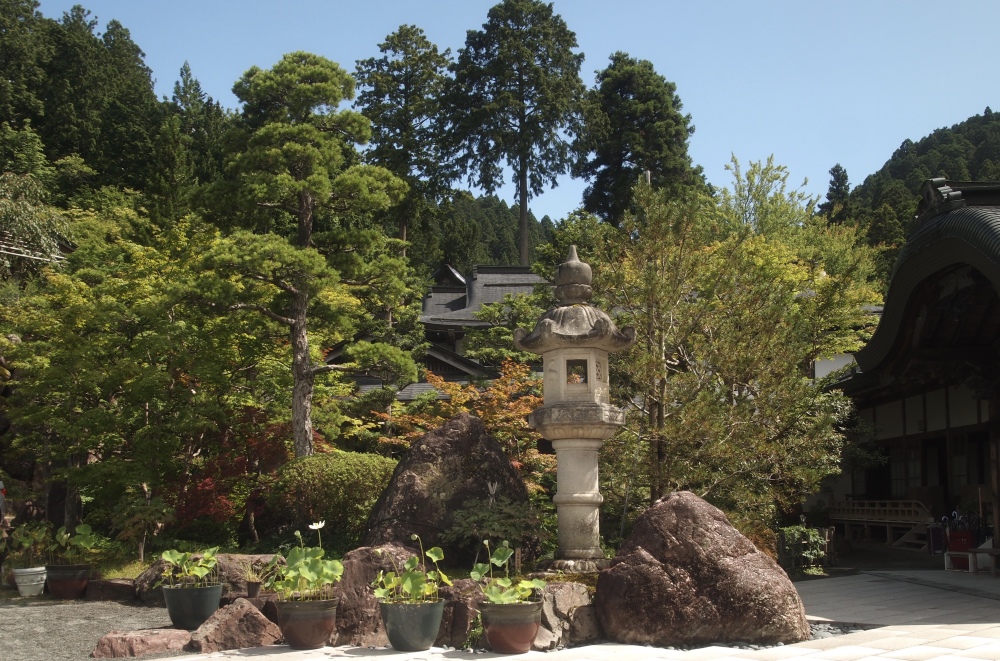
Ekōin

Ekōin

Ekōin
Karukayado Temple tells the story of Karukaya-Doshin and Ishidomaru in panels spread around the inside perimeter. You can read some of the story here.

Karukaya-Doshin and Ishidomaru

Karukaya-Doshin and Ishidomaru
The first panel depicts the feudal lord, Kato-Hyuoenojo-Shigemase, who lived in modern Fukuoka prefecture over 800 years ago. He had no children, so he prayed at Kashii-no-miya shrine. As a result, he was blessed with a child. When the child grew up, he was named Kato-Saemon-Shigeuji and was later given the name Karukaya-Doshin.

the feudal lord prays for a child
The rest of the story of Karukaya-Doshin and Ishidomaru encircles the temple in panels, with the story written in both Japanese and English.

story of Karukaya-Doshin and Ishidomaru

story of Karukaya-Doshin and Ishidomaru

story of Karukaya-Doshin and Ishidomaru

story of Karukaya-Doshin and Ishidomaru

story of Karukaya-Doshin and Ishidomaru

story of Karukaya-Doshin and Ishidomaru
I continue walking down the main road and climb steps under a series of torii gates to explore Kiyotaka Inari Shrine.

Kiyotaka Inari Shrine

Kiyotaka Inari Shrine

Kiyotaka Inari Shrine
A small family seems to be in charge of this shrine. The father and son point to the cedar trees that meet and grow together near their tops.
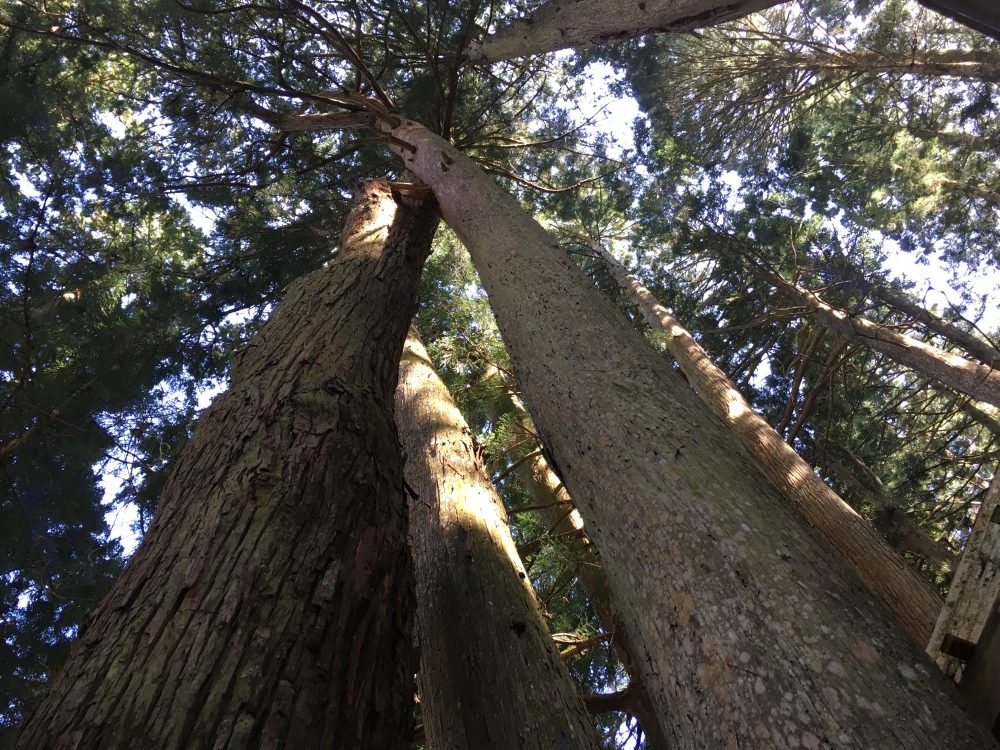
cedars growing together at Kiyotaka Inari Shrine

guardian dog

Kiyotaka Inari Shrine

Kiyotaka Inari Shrine
The boy offers me a cup of tea and a snack, which I enjoy as I haven’t yet had lunch and it’s near 2:30.

tea, snack and origami

boy at Kiyotaka Inari Shrine
As I continue my walk down the street, I find a contemplative monk clopping down the sidewalk in wooden sandals.

a monk walks by a Koyasan temple
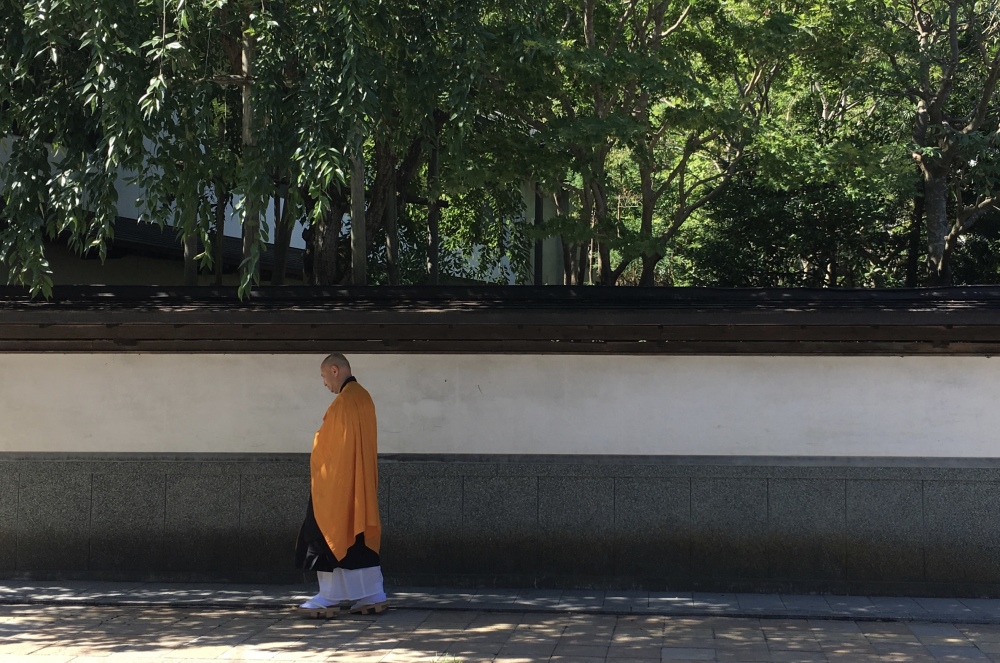
a monk in motion

Koyasan temple
I find a late lunch in a small unpretentious cafe.

lunchtime cafe

lunchtime
At 3:10, I’m tired and hot from all my walking. So I go to Kumagaiji, my temple lodging for tonight, and simply walk around the temple and the grounds for a short time.

Kumagaiji

Kumagaiji

Kumagaiji

Kumagaiji

Kumagaiji

ema at Kumagaiji

ema at Kumagaiji

Kumagaiji

Kumagaiji
The grounds of Kumagaiji have the typical Japanese garden with a pond and stone lanterns.

Kumagaiji grounds

Kumagaiji grounds
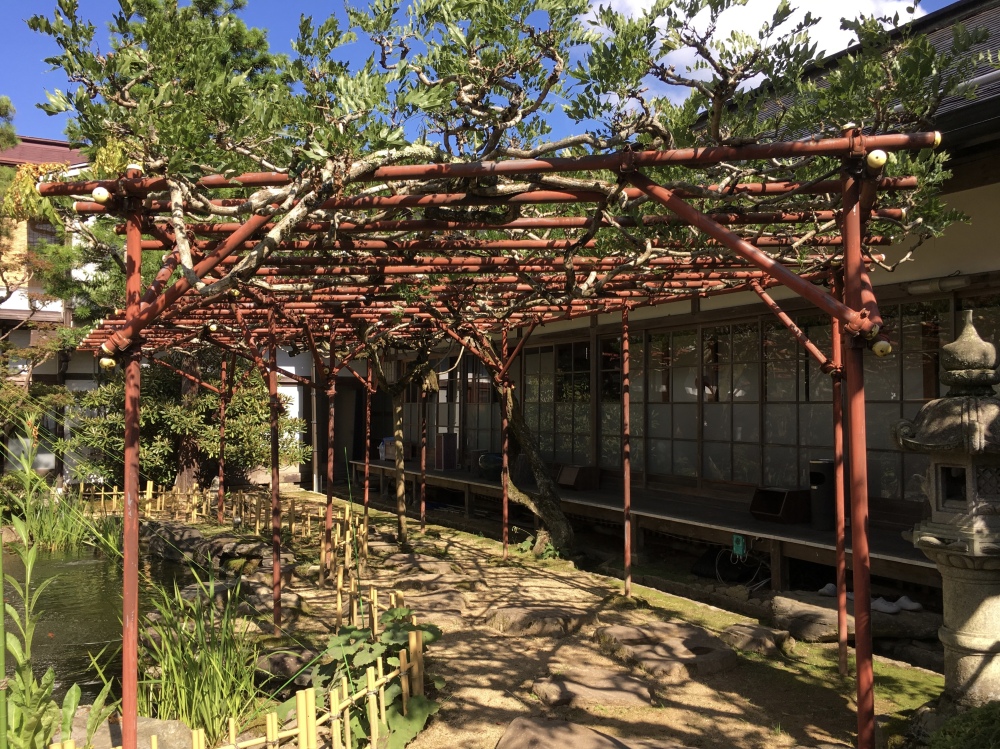
Kumagaiji grounds

Kumagaiji grounds
Finally, I lie down on my futon in my small tatami-matted room with a fan blowing directly on me. Last night, at Kongo Sanmaiin, the temple was air-conditioned, but this one is not, and it’s quite miserable. The fan just doesn’t work to cool me off, but I try to take a short nap anyway.
The Kumagaiji guests sit down for dinner at 5:30.
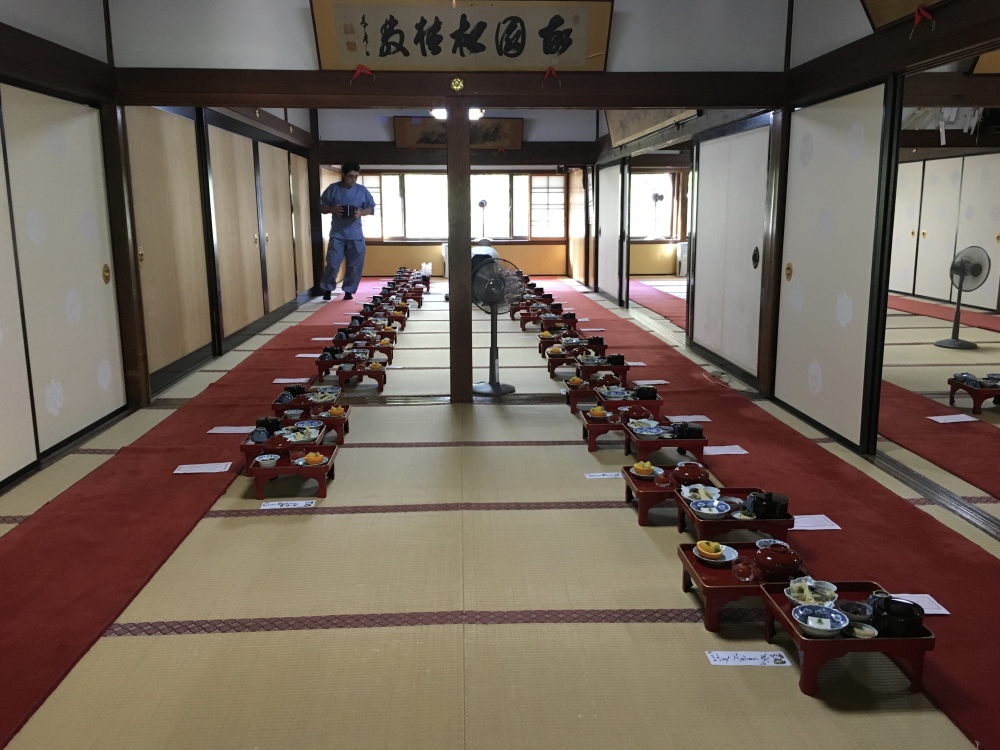
dinner at Kumagaiji
The dinner is quite similar to the one I had last night at Kongo Sanmaiin, but it isn’t quite as good. Maybe because of the heat…

dinner at Kumagaiji

my seating assignment

dinner at Kumagaiji
In the middle of our dinner at Kumagaiji, a Japanese lady from the temple’s staff alarms us with news that a typhoon is coming overnight. She warns that the typhoon might shut down the cable car and thus not be able to take us down the mountain in the morning. As I have a 7-hour trip from Koyasan to Narita planned for tomorrow, and an early flight back to the U.S. on Tuesday morning, I am worried that I might not make it to Narita tomorrow. After debating with myself in my sweltering room for a half-hour after dinner, I quickly make a reservation at Osaka Garden Palace, pack up my bag and check out of the temple lodging, losing the 12,000 yen (~$110) I already paid. I catch a bus to Koyasan Station, where I catch the 7:50 p.m. cable car to Gokurakabashi Station. The cable car is deserted except for a Spanish guy and a Japanese girl, both of whom speak a little English and take me under their wings. They are also headed to Osaka, so we decide to stick together.
We catch the 7:59 Nankai-Koya Line to Hashimoto Station, arriving at 8:46, and then stay on the line to Namba Station.
This is what the Nankai-Koya train line to Namba Station looks like at 9:14 p.m., nearly deserted. We arrive almost an hour after leaving Hashimoto Station, at 9:35.

on the Nankai-Koya Line to Namba Station
At Namba Station, I have six minutes before I must catch the Midosuji Line to Shin-Osaka, so I jump off the train and use the bathroom; luckily there’s a toilet right at the end of the platform. I make it back to the train on time, but as I get back on a different car, I lose sight of the Spanish guy and Japanese girl. They had offered to get off with me, but I told them not to worry, I’d be fine on my own.
At 9:57 p.m., I arrive at Shin-Osaka Station, where I buy a Shinkansen ticket for 8:40 a.m. Monday morning to Tokyo. I know I will need to get an early start because the typhoon is expected to hit the Kansei area in late morning. I’ve heard that even the Shinkansen might stop running in typhoon weather. I can’t abide any delays because I certainly don’t want to miss my flight home on Tuesday morning.
I have a Google Map on my phone showing me how to get from Shin-Osaka Station to the Osaka Garden Palace. It looks like about a half-mile walk. It isn’t easy to find. It takes me an hour, lugging my suitcase through a mostly residential and quite deserted area of Osaka, to find the hotel. I finally happen upon two women taking a walk, one of whom luckily speaks a little English, and points me in the direction of the hotel. I finally arrive at 11:00 p.m. exhausted and annoyed that I have to spend another 7,000 yen (~$64) for lodging, when I already paid for the night at Kumagaiji.
So much for my relaxing temple stay, and the cold beer that enticed me from the temple’s vending machine!
Steps today: 23,485 (9.95 miles). Whew! What a day. 🙂
Sunday, August 6: Early this morning, I participate in a Buddhist ceremony at Kongo Sanmai-in, the temple where I spent the night. Kongo Sanmai-in is one of Kōyasan’s 52 shukubo, temples that historically offered overnight lodging to pilgrims, but today offer accommodation to non-pilgrim tourists as well. Both Japanese and Western visitors participate in this morning’s service, although the entire ceremony of prayer, guided meditation, chanting, and even the sermon, are in Japanese. Even without understanding a word, the service is gorgeously moving, with gongs and chants and incense swirls transporting us to an otherworldly realm. At one point during the service, participants are invited to walk up and put a flower bud in a bowl, offering silent prayers. At another point, the monks lead us in a slow procession through a passageway that circles the main altar of the temple. We listen to the head monk give a long talk in Japanese, maybe 30 minutes; his words elicit a lot of laughs from the Japanese visitors. Someone tells me later that he was talking about the exorbitant costs of renovating the temples and pagodas.
Sadly, I have to check out of Kongo Sanmai-in this morning because they are booked for the second of my two night stay. I have to move a block or so up the main road to Kumagaiji, another temple where I’ll stay the night. Sadly, I find this temple is not air-conditioned, as was Kongo Sanmai-in. The room is sweltering, as is the entire temple. It’s no problem during the day, as I’ll be out and about, but at night, it won’t be pleasant.
My goal today is explore the rest of Kōyasan, especially the atmospheric cemetery of Okunoin, one of the most sacred places in Japan and a popular pilgrimage spot, as well as Kongobuji Temple. Tomorrow morning, Monday, I have a 7+ hour trip from Kōyasan to Narita, where I’ll spend the night before my Tuesday flight back to Virginia.
After leaving my bag at Kumagaiji, I walk along the main road, passing by several temples along the way. First, I walk by Daien-in, a shapely building with a Japanese cypress bark roof. The outer gate and entrance are carved with Japanese bush warblers, plum trees, and the twelve animals of the Chinese zodiac.

Daien-in
A bit further down the road, I drop into the Manihouto Pagoda at Jofukuin Temple. Here, a cheery monk is manning a welcome window, although he doesn’t speak much English. He does manage to tell me the pagoda is meant to honor those who died in WWII.

Manihouto Pagoda at Jofukuin Temple

inside Manihouto Pagoda

inside Manihouto Pagoda

inside Manihouto Pagoda

inside Manihouto Pagoda

inside Manihouto Pagoda

inside Manihouto Pagoda
The monk inside Manihouto Pagoda writes something on an all-Japanese pamphlet and I am hopeful it contains some kind of fortune for me. I later find out it’s just the name of the temple, or something having to do with the temple.

a monk inside Manihouto Pagoda
The monk demonstrates that I should pull the wooden beads, shown below, very gently, beginning with my left hand, then right, then left. I am to reach for the next bead with my eyes closed and whichever one I touch tells my fortune. Directly in front of me is a sign telling the meaning of each symbol. When I touch the bead with the yellow star, the monk gives me an exuberant hug. He points to the sign, which says the star = Great blessing. Other symbols are lesser blessings. What a lucky soul I am sometimes. 🙂

pull the cord for a fortune

symbol meanings
I leave the beautiful Manihouto Pagoda and continue up the road toward Okunoin.

Manihouto Pagoda at Jofukuin Temple
I pass by Sekishoin. Founded 1100 years ago, it is now a shukubo.

Sekishoin

Sekishoin
I also pass Shojoshin-in, another shukubo with beautiful grounds.

Shojoshin-in
Okunoin, the focal point of religious faith in Kōyasan, is an atmospheric ancient cemetery that holds more than 200,000 tombs of departed people of all classes, from common townsfolk to military commanders. The cemetery sprawls out along a 2km path through several-hundred-year-old towering cedar trees.
Most importantly, Okunoin is the site of the mausoleum of Kobo Daishi, also known as Kukai (774-835), the founder of Shingon Buddhism and one of the most revered persons in the religious history of Japan. Kobo Daishi is not considered to have died but is believed to rest in eternal meditation as he awaits Miroku Nyorai (Maihreya), the Buddha of the Future; he provides relief to those who ask for salvation in the meantime (japan-guide.com: Okunoin). Many people, including prominent monks and feudal lords, have had their tombstones built here over the centuries in hopes of being close to Kobo Daishi in death so they can receive salvation.
I pass the water pavilion near the entrance of Okunoin, and then I’m on my way across Ichinohashi bridge.

Water pavilion at Okunoin
The Ichinohashi Bridge (first bridge) marks the traditional entrance to Okunoin. It is said that Kobo Daishi comes here to greet visitors and sees them off here. Pilgrims bow here before crossing the bridge.
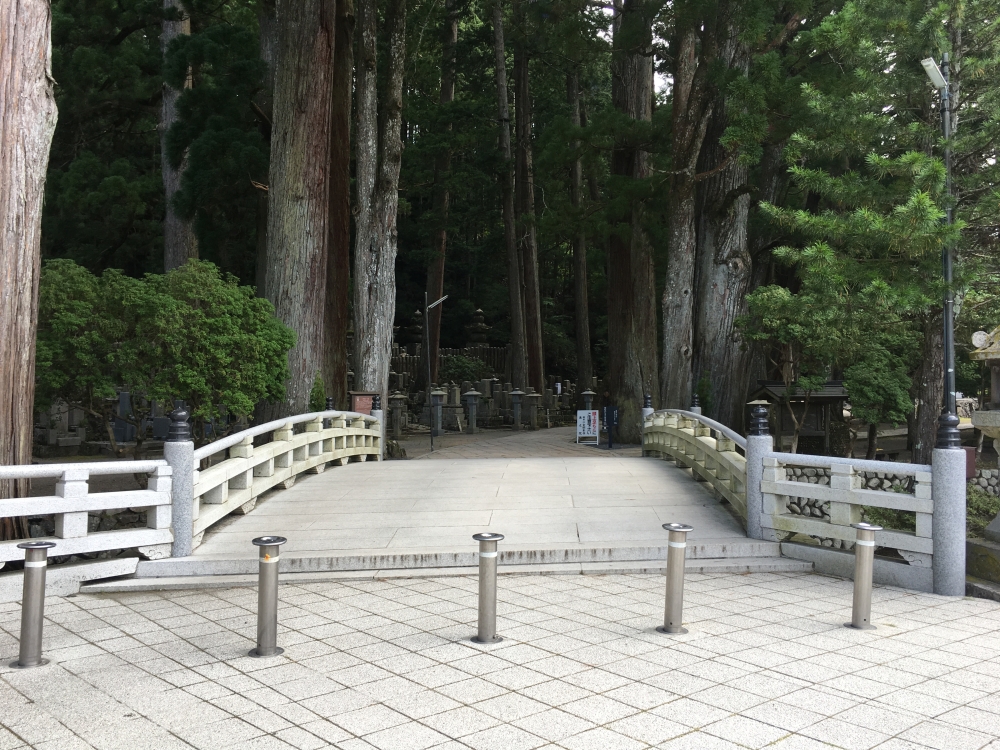
Ichinohashi bridge
I stroll through the mystical Okunoin for an hour and a half, mesmerized by the moss-covered tombs and lanterns, the brightly bibbed Jizo statues, and the soaring cedars. Though it seems the cemetery might be cool in the shade from those cedars, they don’t help in today’s heat, nearly 95F degrees and oppressively humid.
I keep following the paved pathway through Okunoin, mindful of the history and holiness here.

path in Okunoin

Jizo at Okunoin
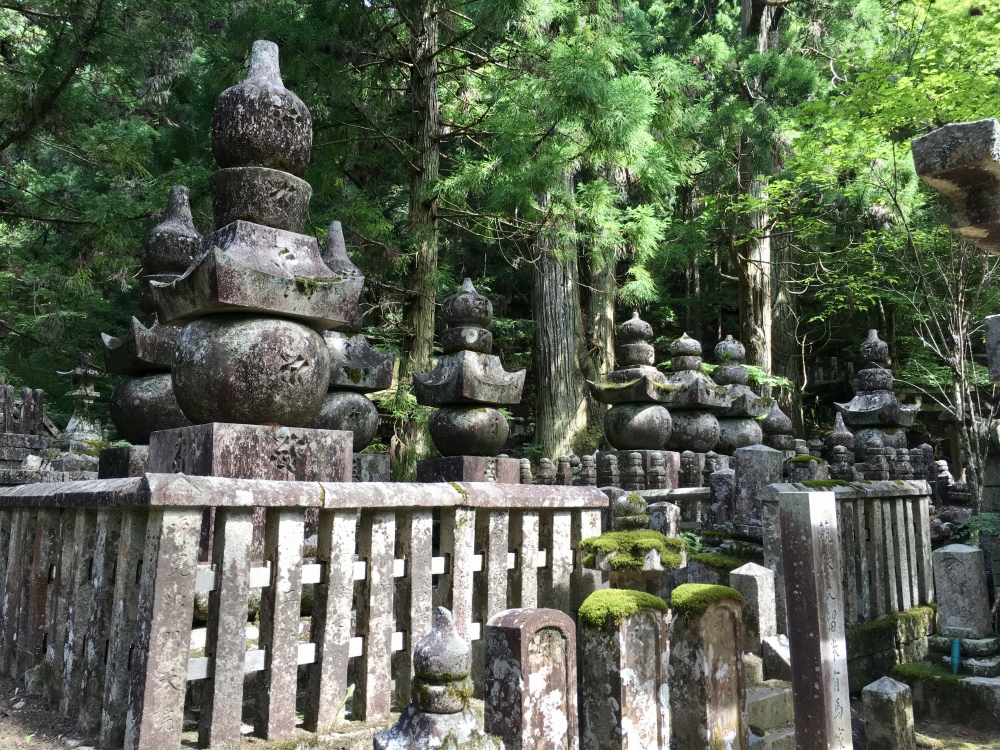
Okunoin
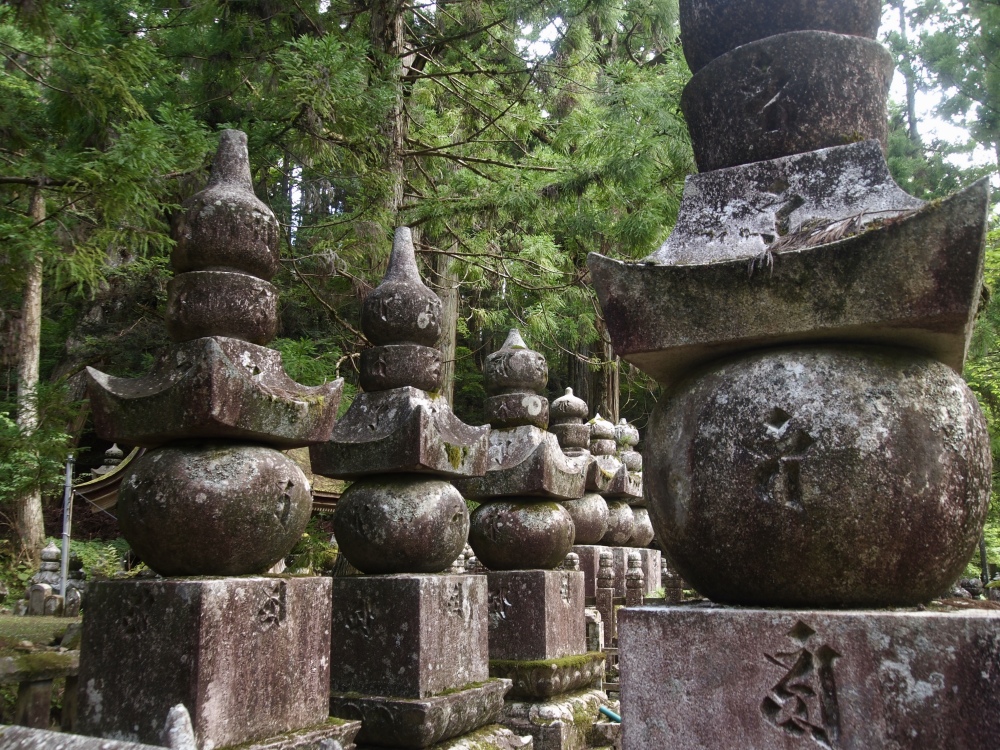
Okunoin

Okunoin

Okunoin
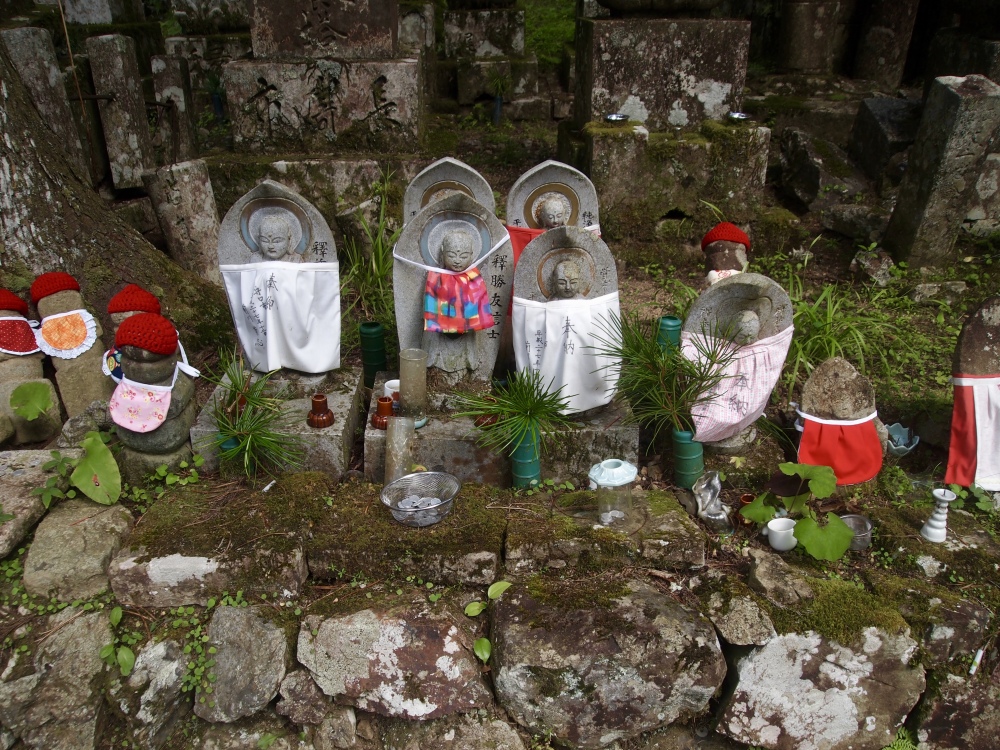
Jizo at Okunoin

Okunoin

Okunoin

Okunoin

Okunoin
Okunoin is overwhelming in its majesty and its serenity. Luckily, I got here early enough that the crowds are somewhat thin this morning.

Okunoin

Okunoin

cedar trees at Okunoin

Jizo in a tree trunk

Okunoin

soaring cedars
I come upon the Graves of Takeda Shingen and Takeda Katsuyori. On the left is a memorial to Takeda Shingen (1521-1573), an important feudal lord, and on the right is that of his son, Katsuyori (1546-1582). Both monuments have the dates of their deaths on the back.

Graves of Takeda Shingen and Takeda Katsuyori

Okunoin

Okunoin

Okunoin

Okunoin

Okunoin

Okunoin
Okunoin seems to go on and on to eternity.

pathway through Okunoin

Okunoin
The black stone statue of Asekaki Jizo (Sweating Jizo), is believed to be always perspiring since it deliberately suffers all sorts of pains on behalf of people because of their wrongdoings. I can’t see the Jizo statue, hidden as it is inside this pavilion. The Mirror Well, also not pictured because I can’t find it, is supposedly adjacent to this statue. According to legend, anyone whose reflection does not appear on the well water is destined to die within three years. Maybe it’s a good thing I don’t find it.

Asekaki Jizo (Sweating Jizo)

Jizo figure at Okunoin

tangled roots of cedars
One of the two pictures below (I’m not sure which) is the Memorial for both Friend and Foe During the Invasion of Korea. This memorial stone was erected to pray for the repose of those killed on both sides during the sixteenth-century Japanese invasion of Korea (1592-1598). It was ordered by Toyotomi Hideyoshi (1537-1598), and built by Shimazu Yoshihiro (1535-1619) and his son Tadatsune (1576-1638) in 1599. The memorial stands within the grave area of the Shimazu family, the lords of Satsuma.

Invasion for both Friend and Foe During the Invasion of Korea

Invasion for both Friend and Foe During the Invasion of Korea
There are both jolly and imposing figures in Okunoin, but I can’t begin to know the significance of them all.
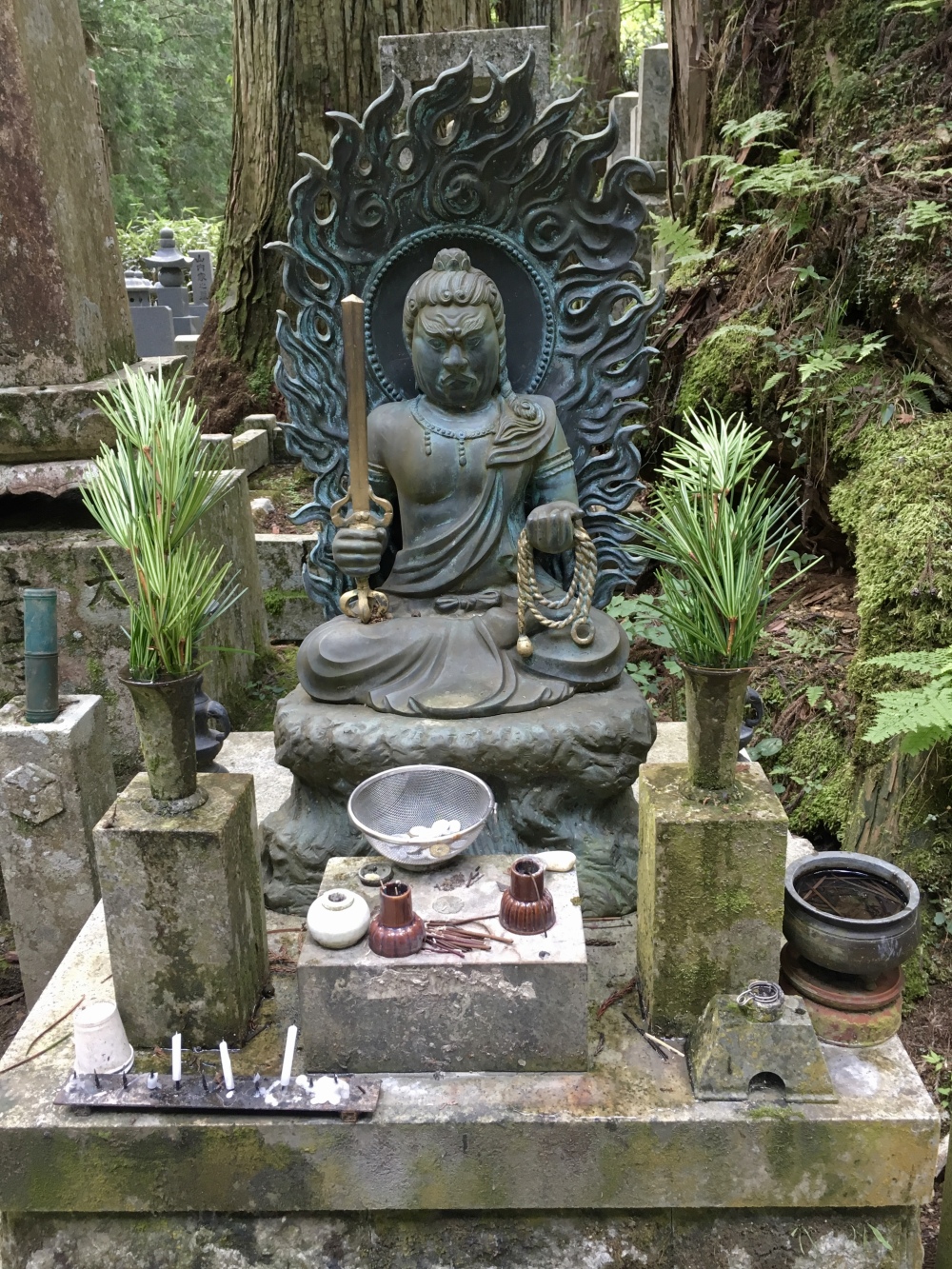
Okunoin
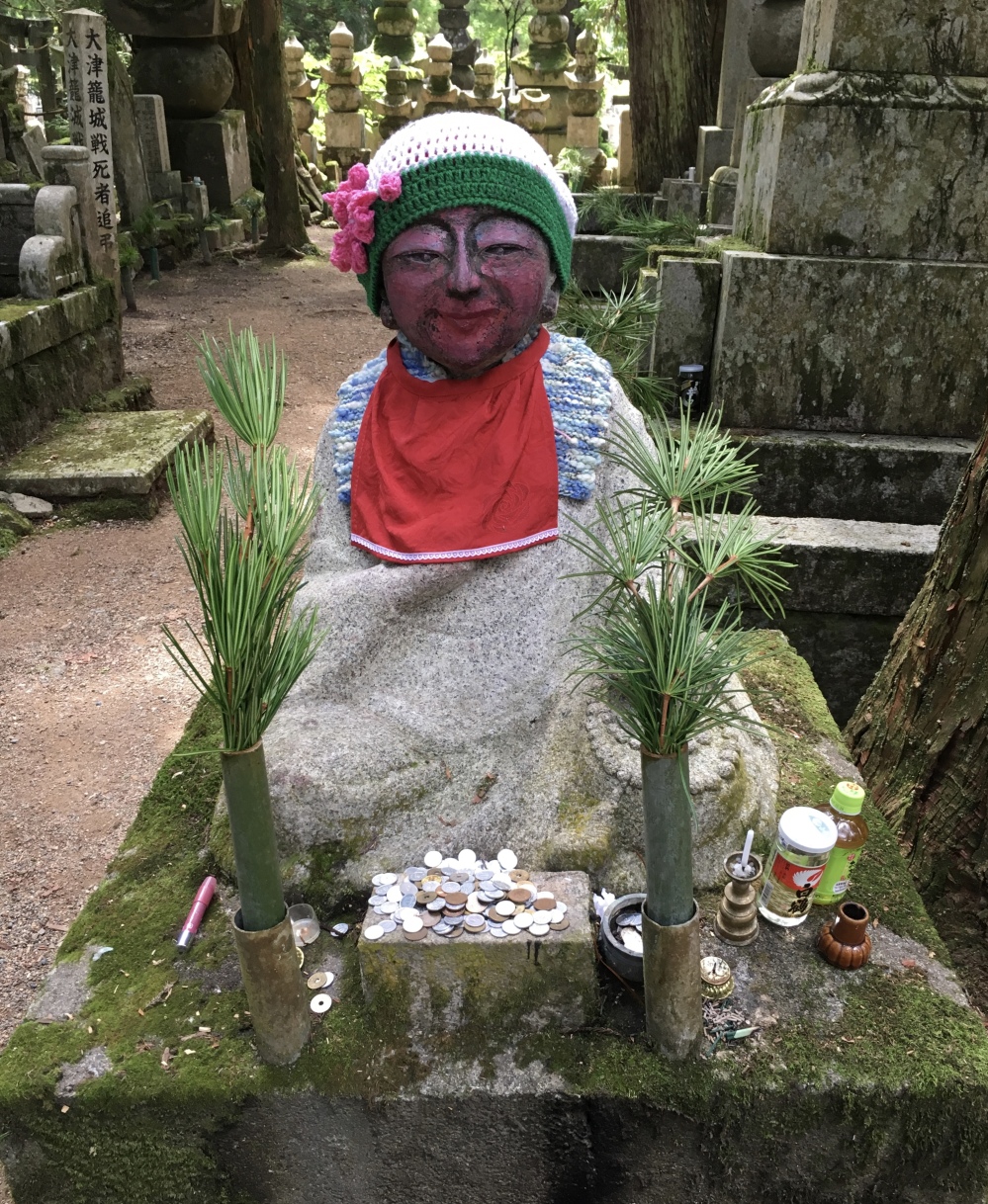
Okunoin

Okunoin

Okunoin

Okunoin
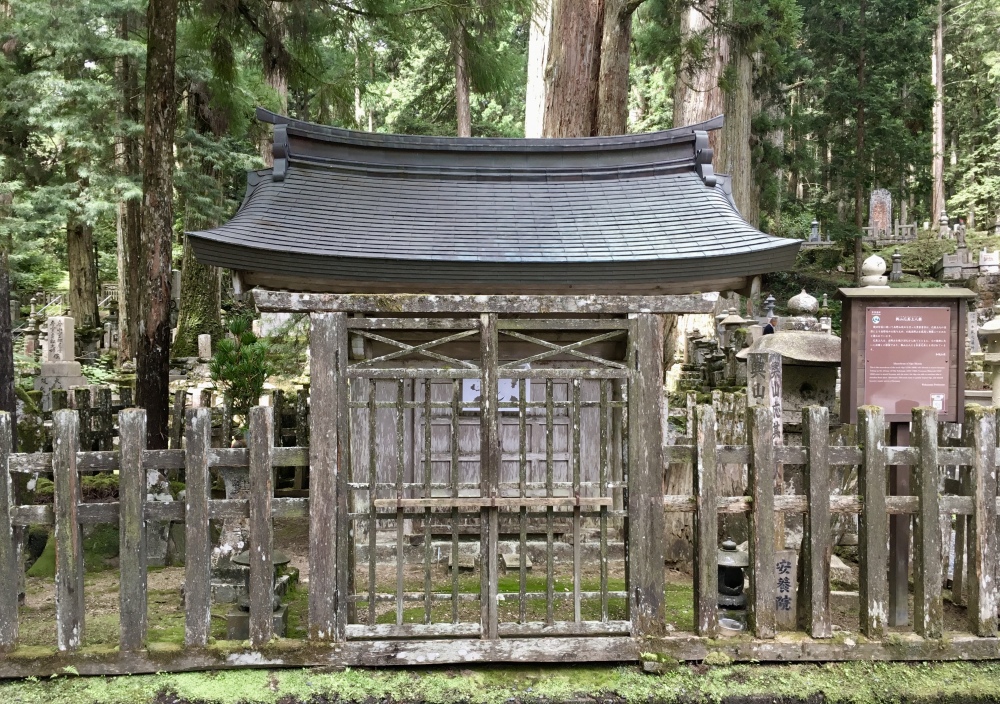
Okunoin
Gokusho Offering Hall lies near a row of statues depicting Jizo, a popular Bodhisattva that looks after children, travelers, and the souls of the deceased.
Visitors make offerings and throw water at the statues, known as Mizumuke Jizo (Water Covered Jizo) to pray for departed family members.

washing the Buddhas
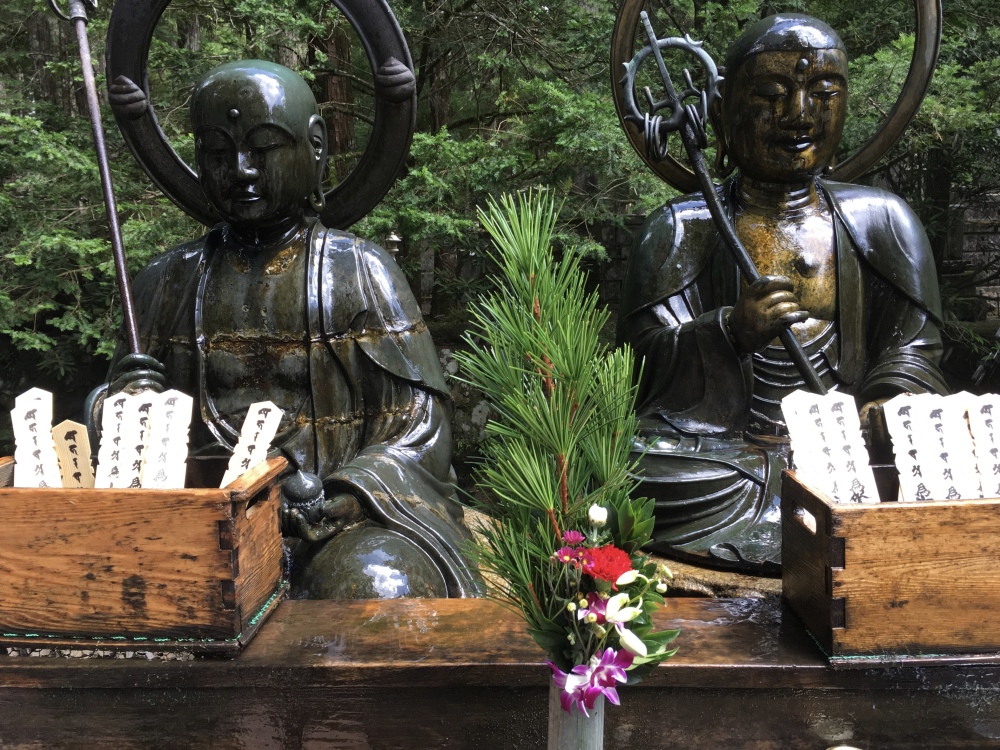
wet Buddhas

Okunoin

Busy washing of the Jizos
The Gobyo-bashi Bridge leads visitors to the mausoleum. Before crossing the bridge and entering the “sanctuary,” it is customary for visitors to groom themselves and bow deeply to Kukai, who is believed to be still alive in the mausoleum and offering prayers for all people in the world.
The bridge, originally a wooden structure, has been rebuilt in stone. The bridge has 36 stone planks, and including the bridge itself, the entire structure represents the Buddhist deities of the Diamond World Mandala. A Sanskrit letter representing each deity is carved on the underside of each plank (japan-guide.com: Okunoin Temple).
Sadly, it’s too crowded to get a photo of the bridge without people on it.

Gobyo-bashi Bridge

Gobyo-bashi Bridge
In the stream to the left of the bridge are a group of wooden markers serving as a memorial to unborn children.

in the river
No photography is allowed once we cross the bridge, but the mausoleum is quite beautiful.
Okunoin’s main hall for worship, Torodo Hall (Hall of Lamps), is built in front of Kobo Daishi’s mausoleum. Inside the hall are more than 10,000 lanterns, donated by worshipers, which are kept eternally lit. In the hall’s basement are 50,000 tiny statues donated to Okunoin in 1984, on the 1150th anniversary of Kobo Daishi’s entrance into eternal meditation.
Behind Torodo Hall is Kobo Daishi’s Mausoleum (Gobyo), the site of his eternal meditation. Visitors come from all over to pray to Kobo Daishi, and it is not uncommon to see pilgrims chanting sutras here (japan-guide.com: Okunoin Temple).
I exit the cemetery at the second entrance to Okunoin, near the Okunoin-mae bus stop. On my way out, I pass a pyramidal mound of Jizo statues.
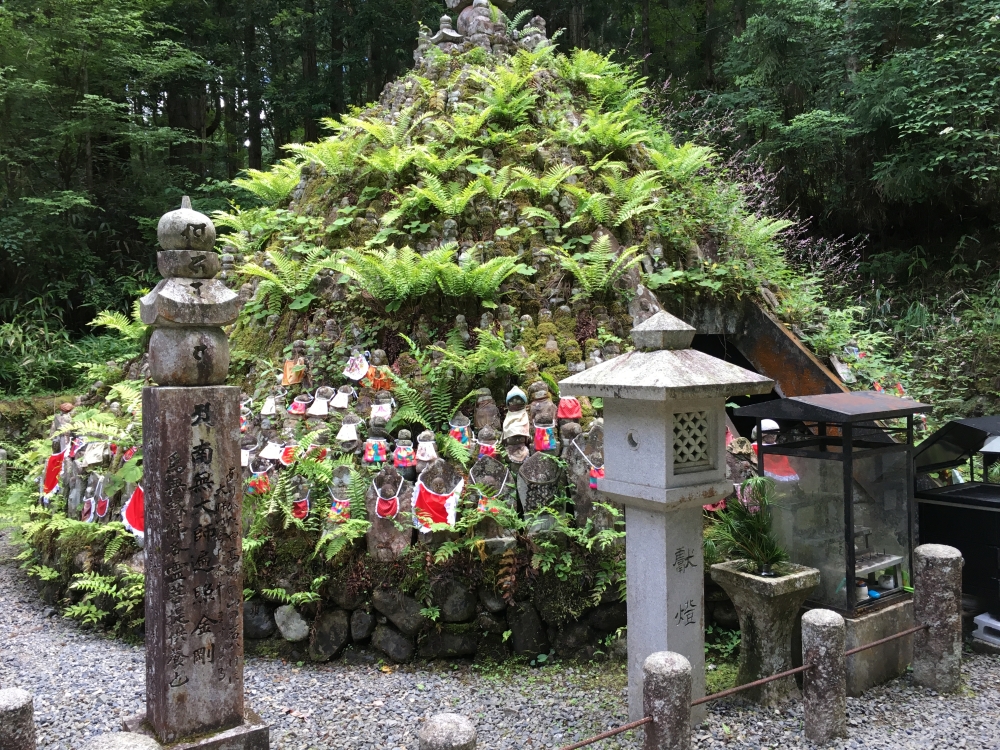
pyramid of Jizos

pyramid of Jizos

Jizo at Okunoin
It’s now about 11:00 a.m., and I stay on the bus until I reach the entrance of Kongobuji Temple, the head temple of more than 4,000 temples of the Shingon sect of Buddhism in the world.
Saturday, August 5: This morning, I leave Nara for the convoluted three-hour journey to Mount Kōya. I take the Yamatoji Line from Nara Station, and at Tennoji Station I change to the Osaka Loop Line to Shin-Imamiya Station, where I take the Nankai-Koya line to Hashimoto Station, about a 45-minute ride. From Hashimoto, I stay on the same line for another 50 minutes to Gokurakubashi Station, where I take the Nankai Koyasan Cable Car up to Mount Kōya. It’s only a 5 minute ride up the cable car.
Below are some views as we climb the mountain.

view from the cable car

view from the cable car

route from Nara to Mount Koya
The sacred mountain of Kōyasan wears a mantle of mystery and holiness. Situated south of the Kinokawa River in Wakayama Prefecture, Kōyasan sits in a basin on a mountain 820 meters above sea level. Kūkai (774-835), a Japanese Buddhist monk posthumously known as Kōbō-Daishi, sent his disciples to explore Kōyasan beginning in 816. It was granted to Kūkai as a place of meditation by the Imperial Court 1,200 years ago. Kūkai was also a civil servant, scholar, poet and artist who founded the Shingon, or “True Word” school of Buddhism. Practitioners at Kōyasan try to identify themselves with the Buddha by spiritual unification.
Ever since the monastic center was formed, Kōyasan has been a holy pilgrimage destination, and also home to unique cultural assets. In 2004, UNESCO designated Mt. Kōya, along with two other locations on the Kii Peninsula, Yoshino and Omine, as well as Kumano Sanzan, as World Heritage Sites: “Sacred Sites and Pilgrimage Routes in the Kii Mountain Range.”
From Kōyasan Station, I must take a bus to Kongo Sanmai-in, where I’ll be staying overnight in a Buddhist temple. Upon my arrival at the temple lodging, I find it’s too early to check in, so I leave my bags with an elderly monk at the front gate and go out to explore Kōyasan. As it’s nearly 1:00, my first order of business is to find lunch, but I find long lines at the few lunch places available. I finally find a restaurant that has some space, and I sit at the counter and enjoy my g0-t0 lunch in Japan, a tempura prawn set meal.

lunch restaurant in Koyasan

shrimp tempura – my go to meal in Japan
After I finish lunch, I go out back to a small outdoor waiting area to use the toilet. There are four available toilets, but only one is Western, so I opt to wait behind four little Japanese girls for the one Western toilet. I find it funny that even the Japanese girls don’t want to use the Japanese squat toilets, but opt to wait for the one Western one. I have to say, I get a little annoyed by this, as the girls take their sweet time to move along.
I walk some distance to Danjo Garan, also known as Dai (Great) Garan, the central temple complex of Mount Kōya. Shingon Buddhism training has been taking place here from the 9th century to the present day.

on the way to Dai Garan

a gate on the way to DAi Garan
I pass a red bridge over a lotus pond that echoes a Monet painting. The Lotus Pond is the largest pond on Kōyasan, and goes back as far as the Heian period (794 to 1185). Originally known as the Kondo pond, it was named the Lotus Pond because of the lotuses growing here. Until the first quarter of the twentieth century, the surface of the lake was entirely covered with lotuses, but because of repairs and construction, the pond’s ecology changed. Hardly any lotuses remain today.

bridge over lotus pond
One gate to the Danjo Garan is called the Chumon, or Middle Gate. The original construction of the Chumon dates back to the founding of Kōyasan. Originally, there was a torii-shaped gate here. After repeated fires and reconstructions, it was rebuilt as a two-story gate with five bays. During the Edo period (1603 – 1868), it is known to have been destroyed by fire three times, and the foundation stones from the before the fires are buried underground.

Chumon, or Middle Gate
The Chumon burned down in 1843 and was not rebuilt for 172 years. Only the foundation stones were exposed at the site until it was reconstructed to commemorate the 1200th anniversary of the founding of Kōyasan in 2015. The images of Dhritarashtra and Vaisravana in the font of the gate date from the reconstruction of 1820.

Guardian King of the Chumon

Guardian King of the Chumon
The Kondo, or main hall, was central to Kūkai’s vision for an esoteric Buddhist monastery secluded in the mountains, flanked by stupas (pagodas) to the hall’s east and west. Though construction began in 819, it wasn’t finished until after Kōbō-Daishi entered eternal meditation in 835. Many rituals and ceremonies are held here.

Kondo, or main hall

Kondo, or main hall

Kondo, or main hall
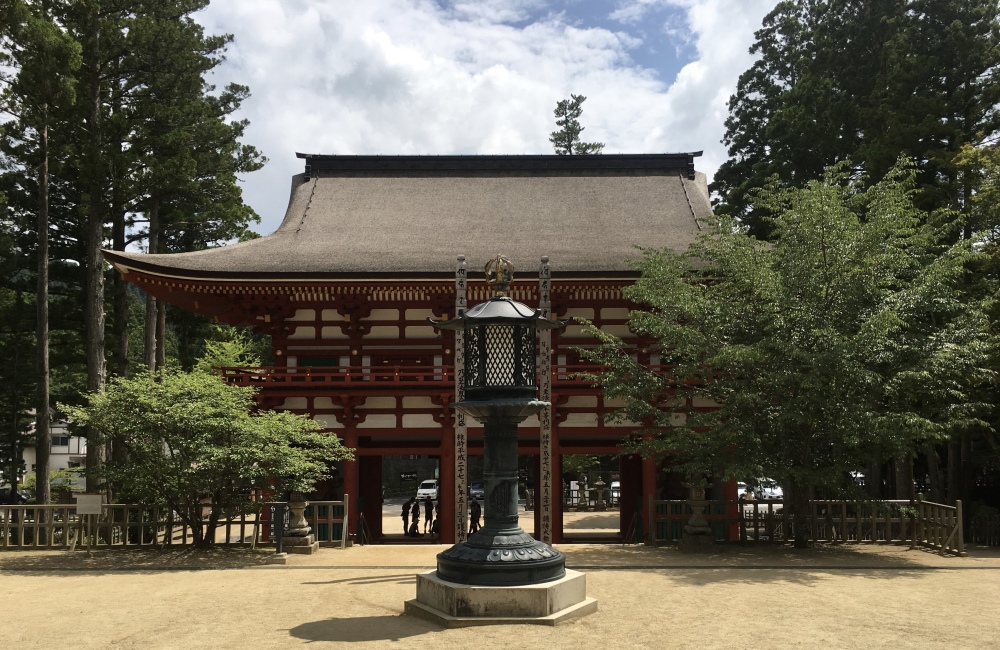
back side of Chumon

Details of the Kondo
The Kondo enshrines a statue of the Medicine Buddha that is not displayed, flanked by two large hanging mandalas, each with its own separate altar. Wall paintings show the eight offering bodhisattvas in the corners, and a large mural of the Buddha’s enlightenment is on the north side of the Kondo.

inside the Kondo

inside the Kondo
Inside the Kondo are wall paintings and murals.

murals inside the Kondo

murals

murals
The hexagonal shaped Rokkaku Kyozo was built in 1159 to house a complete copy of the Buddhist scriptures, written in gold ink. The building was lost in the fire of 1843, was rebuilt in 1884, and was lost again in the fire that destroyed the Kondo in 1926. The existing building was rebuilt in 1934. The 1884 building could be revolved, but only the present building’s outer rim can be revolved.
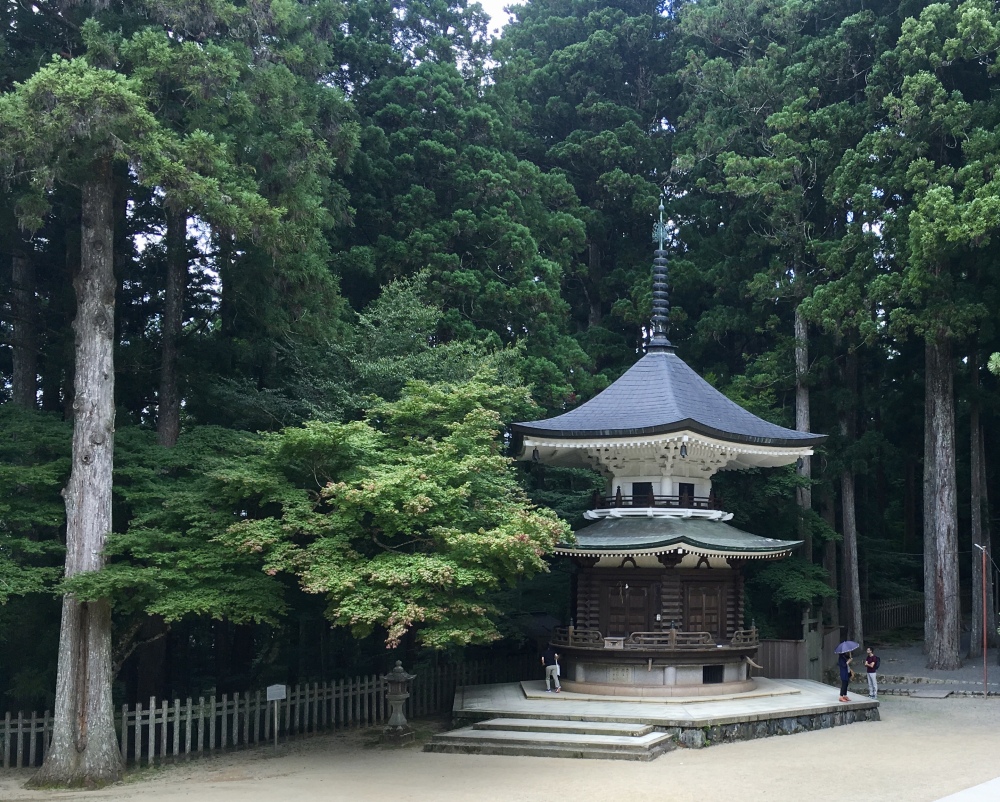
Rokkaku Kyozo
Konpon Daito, or the Great Fundamental Pagoda, is the tallest building in Kōyasan. After Kūkai was granted the use of Kōyasan by Emperor Saga in 816, he decided to build the first monastic complex entirely dedicated to the teaching practice of Esoteric Buddhism. He planned to construct two large two-story pagodas diagonally behind the Kondo in the eastern and western directions. Plans called for the Konpon Daito to be about 48.5 meters high, and because of its great size it was finally completed in 876, about 40 years after Kōbō-Daishi entered eternal meditation.

Konpon Daito, the stupa on the east side of the Kondo
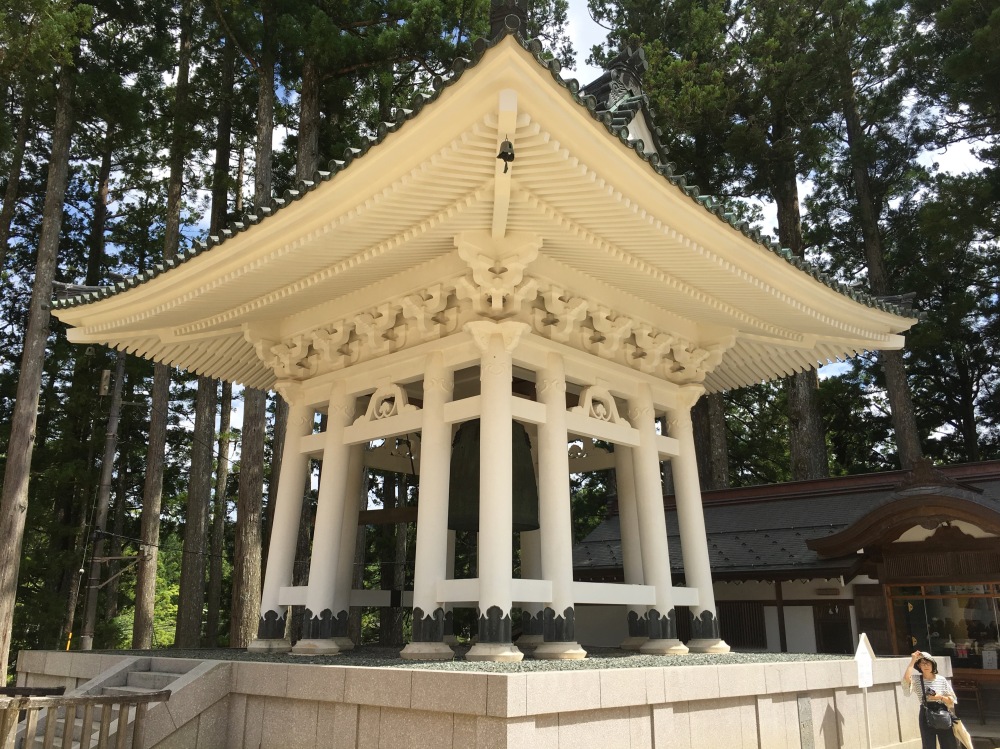
Shoro Belfry at Dai Garan
In later centuries the Konpon Daito was destroyed in fires caused by lightning strikes five times, and rebuilt each time. After the great fire of 1843, only the foundation stones remained. The existing building was rebuilt in 1937 of ferro-concrete with wooden overlays painted in vermilion because of the long history of fires. The building was last renovated in 1996.
The body of the pagoda is circular, with a square lower story with an attached pent roof and walls. The majestic Konpon Daito has the exact dimensions today was when it was first built. It enshrines a three-dimensional mandala, with large gilt wooden statues of Dainichi Myorai (Mahavairocana) of the Taizokai (Matrix Realm) surrounded by the Four Buddhas of the Kongokai (Diamond Realm), with the Sixteen Great Bodhisattvas painted on the sixteen pillars around them. Sadly no photography is permitted.
Konpon Daito is known as a symbol of Kōyasan.
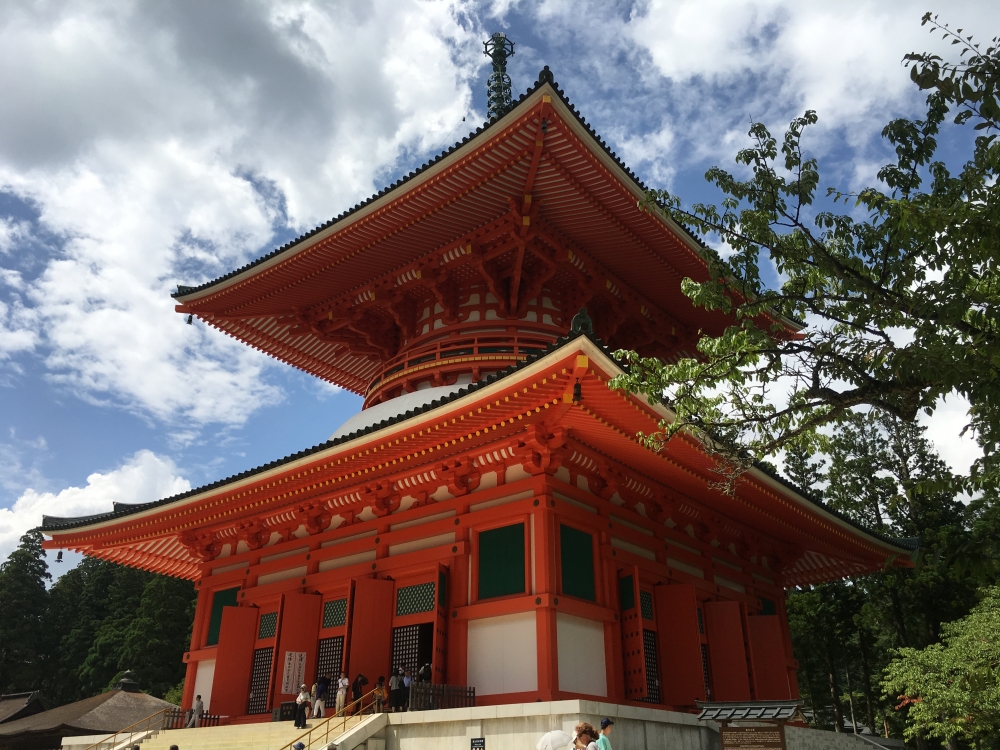
Konpon Daito

hall at Dai Garan
The Tōtō (Eastern Stupa) was completed in 1127 at the wish of the retired Emperor Shirakawa. The main deity enshrined is Vikiranosnisa, who is flanked by two wrathful deities. The pagoda that had been rebuilt in the Edo period burned to the ground in 1843, and the present building was reconstructed some 140 years later, in 1983.

Tōtō (Eastern Stupa)

Tōtō (Eastern Stupa)

Konpon Daito

Konpon Daito

bronze lantern and Kondo

a monk walks by the bronze lantern

hall at Dai Garan

pavilion at Dai Garan
Myō-jinja is home to Niu-myōjin, the royal mistress of Mount Kōya, and her son Kariba-myōjin, hunter guardian of the mountain’s forests. Most of Dai Garan is shaded by soaring black cedar trees.
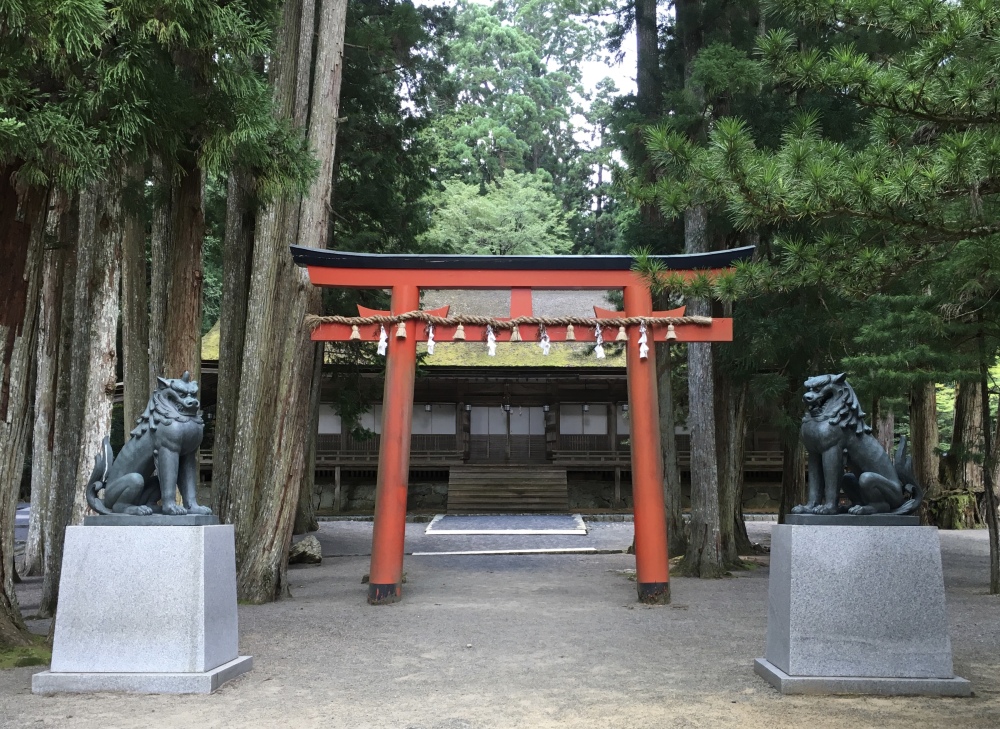
torii at entrance to Myō-jinja

Sannoin
The Saito, or Western Stupa, was originally built in 887, according to the instructions of Kōbō-Daishi. The present structure is the fifth reconstruction of the original building, and was built in 1834. The 36 pillars inside, plus the central pillar, represent the 37 deities of the Kongokai Mandala. Five Buddhas are enshrined here, with the central Buddha being Mahavairocana of the Kongokai surrounded by four Buddhas of the Taizokai. This demonstrates the teaching of the non-duality of the two mandalas.
I always love the older buildings that haven’t been rebuilt in ferro-concrete, like this one, although I know fires have destroyed these wooden buildings many times.

The Saito, or Western Stupa

The Saito, or Western Stupa

tree roots at Dai Garan

Konpon Daito
I wander over the red bridge to the islet in the center of the Lotus Pond.
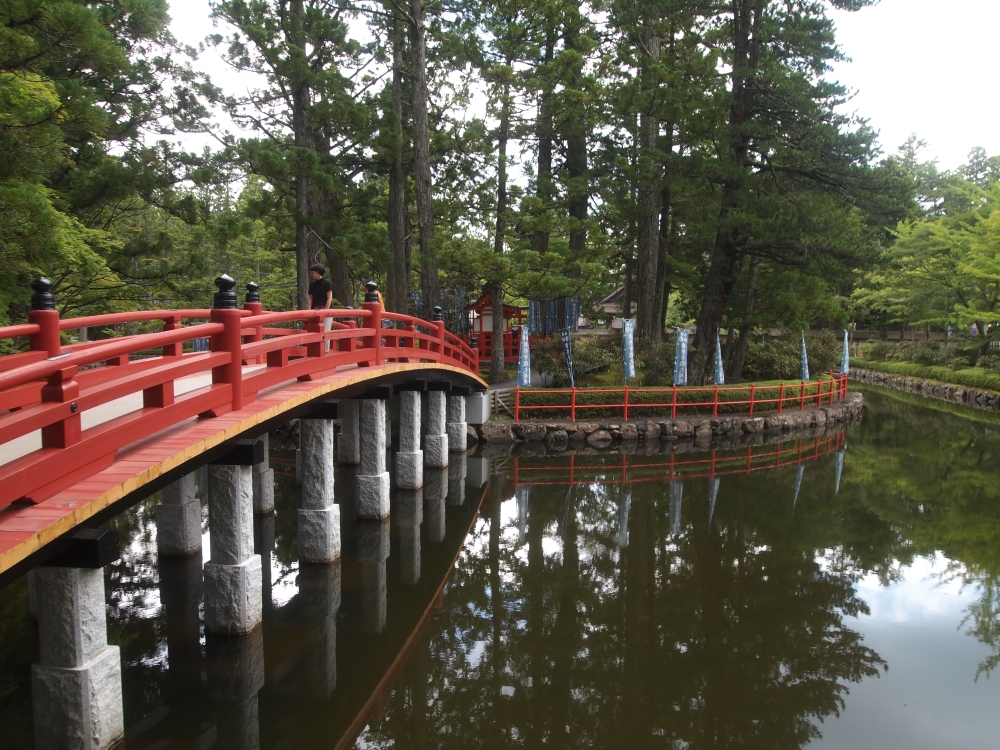
bridge over lotus pond
On the small islet is the Zennyo Ryuo Shrine, which enshrines a queen of the Naga, or dragon gods, believed to be most powerful in answering prayers relating to water and rain. This shrine originated when a monk prayed to the queen for rain during the drought of 1771.

Zennyo Ryuo Shrine
Situated at the west end of the basin of Koyasan, the Daimon, or Grand Gateway, is the western entrance to Koyasan from Kinokawa Valley and Aritagawa Valley. The gateway was reconstructed in 1705. It was recently repaired when the motorway opened.
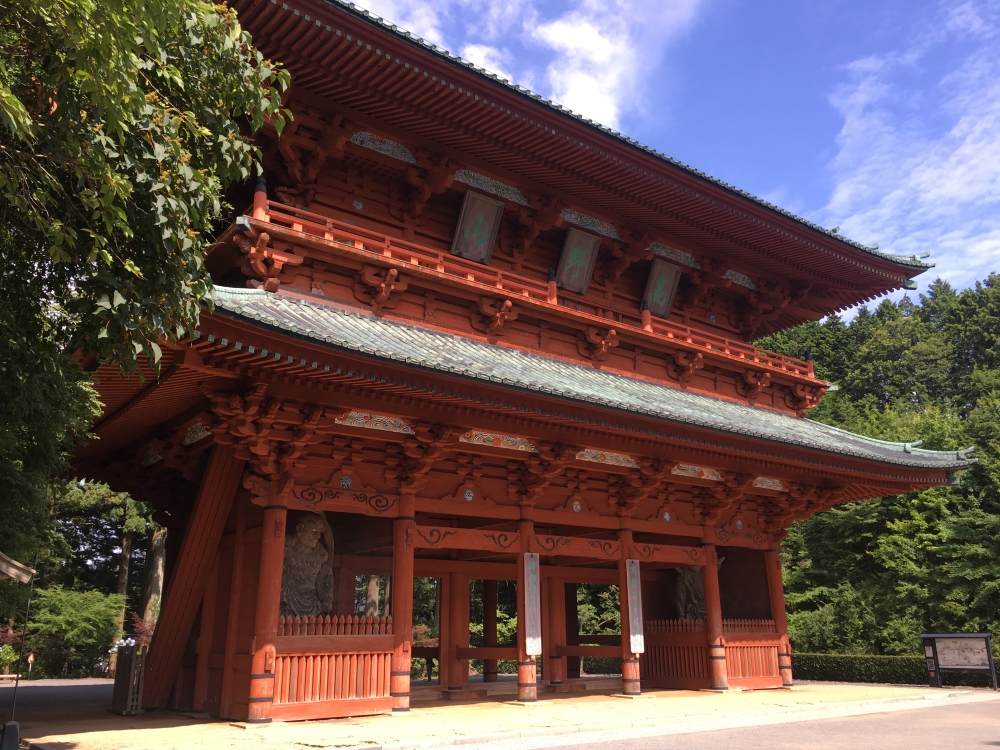
The Daimon, or large entrance gate, to Dai Garan
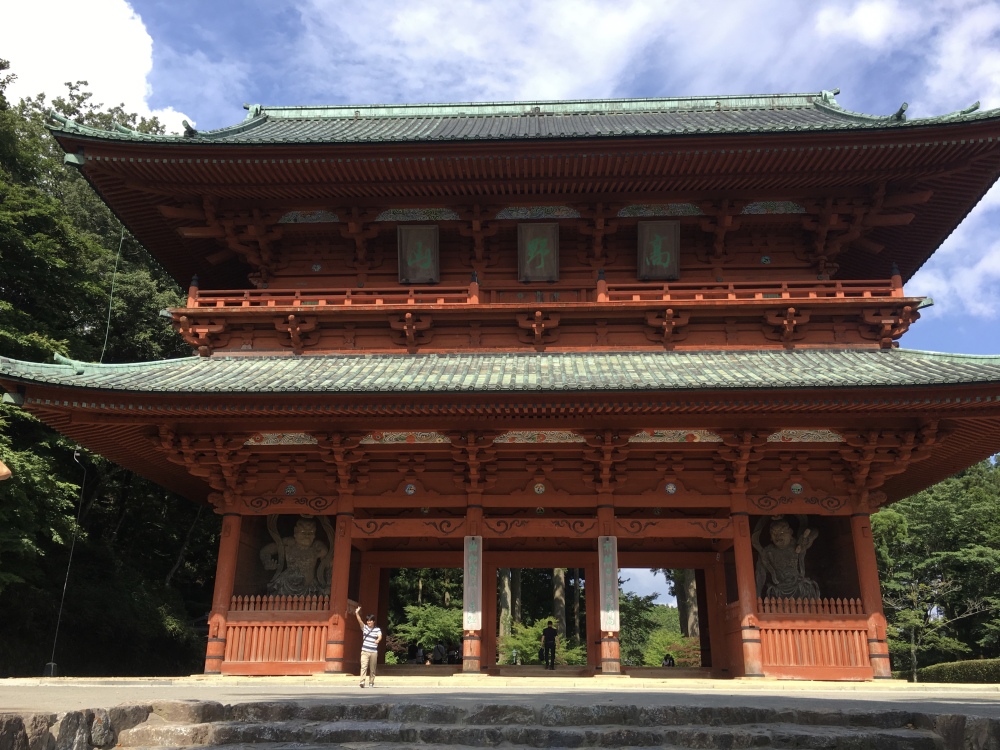
The Daimon
Inside the two main pillars of the gates are fierce looking Niō statues, guardians of this sacred area.

Niō statue

Niō statue
Temple Stay at Kongo Sanmai-in
After exploring all around Dai Garan, I walk back to Kongo Sanmai-in, where I can check in for the night.
Temple lodgings, or shukubō, are Buddhist temples that offer overnight accommodation to pilgrims and tourists. Open to both practitioners and non-practitioners, shukubō offer travelers a chance to experience the austere lifestyle of Buddhist monks while staying in historic temple buildings. In addition, visitors are usually invited to watch or participate in activities such as morning prayers or meditation (Japan-guide.com: Temple Lodgings). Of 117 temples on Koyasan, 52 of them offer lodging for overnight guests.
Kongo Sanmai-in is also considered a ryokan, or traditional Japanese inn. It has a bathhouse, multi-course dinners, communal spaces where guests can relax, and rooms with woven-straw flooring and futon mats.
The temple was built in the year 1223 by a widow named Hojo Masako, wife of the feudal lord Minamoto Yoritomo. She is said to have been the most powerful woman in Japanese history. Madam Masako became nun Nyojitsu after her husband died. She protected Kongo Sanmai-in Monastery by appointing a head priest, donating manors to the monastery, and encouraging Buddhist learning by establishing a school for learning. Yasumori, her vassal, supplied the priests with scriptures and commentaries on wooden block printing.
Kongo Sanmai-in is one of the most expensive places I stay during my time in Japan. It costs me 14,540 yen, or ~ $134. Dinner and breakfast are provided, and we are able to participate in the morning Buddhist ceremony. I have a small tatami-matted room to myself with a private bathroom. The whole experience is well worth the price.

Kongo Sanmai-in
After I settle into my air-conditioned room with private bath, I walk around to explore the grounds before dinner. I find the beautiful two-story Hato tower, dating to the 13th century.

stupa at Kongo Sanmaiin

stupa at Kongo Sanmaiin

a peek through the hydrangeas

stupa at Kongo Sanmaiin

on the grounds of Kongo Sanmaiin

Kongo Sanmaiin
The black cedar trees at Kongo Sanmai-in are ancient and majestic.

cedar trees at Kongo Sanmaiin

cedar trees at Kongo Sanmaiin
The Shisha Myojin Honden Shrine, a Shinto shrine housing the tutelary deity of Kongo Sanmai-in Temple, is inscribed with the date 1552.

Kongo Sanmaiin Temple Shisha Myojin Honden Shrine

Kongo Sanmaiin Temple Shisha Myojin Honden Shrine

path uphill
Like the stupa, this scripture repository building was also built in the Kamakura period. It is a rare example of the traditional azekurazukuri style, a simple wooden construction used in buildings like storehouses (kura), granaries, and other utilitarian structures. It is characterized by joined-log structures of triangular cross-section, and is commonly built of cypress timbers.

scripture repository

scripture repository

rakan at Kongo Sanmaiin

Kongo Sanmaiin

the grounds of Kongo Sanmaiin

Kongo Sanmaiin
I walk through the polished wooden halls of Kongo Sanmai-in and then through the interior courtyard garden. This is truly a comfortable and serene temple for a temple stay!

inside Kongo Sanmaiin

painted screen at Kongo Sanmaiin
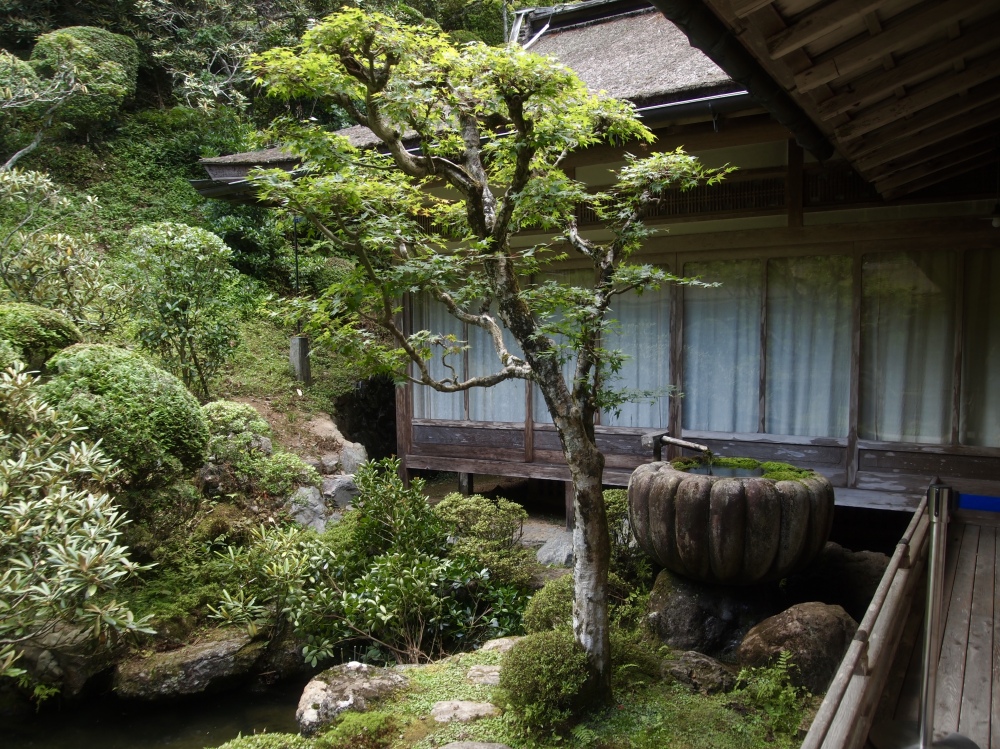
garden at Kongo Sanmaiin

garden at Kongo Sanmaiin

garden at Kongo Sanmaiin

garden at Kongo Sanmaiin

Kongo Sanmaiin

garden at Kongo Sanmaiin

another courtyard at Kongo Sanmaiin
I finish walking the grounds of Kongo Sanmai-in.

Kongo Sanmaiin
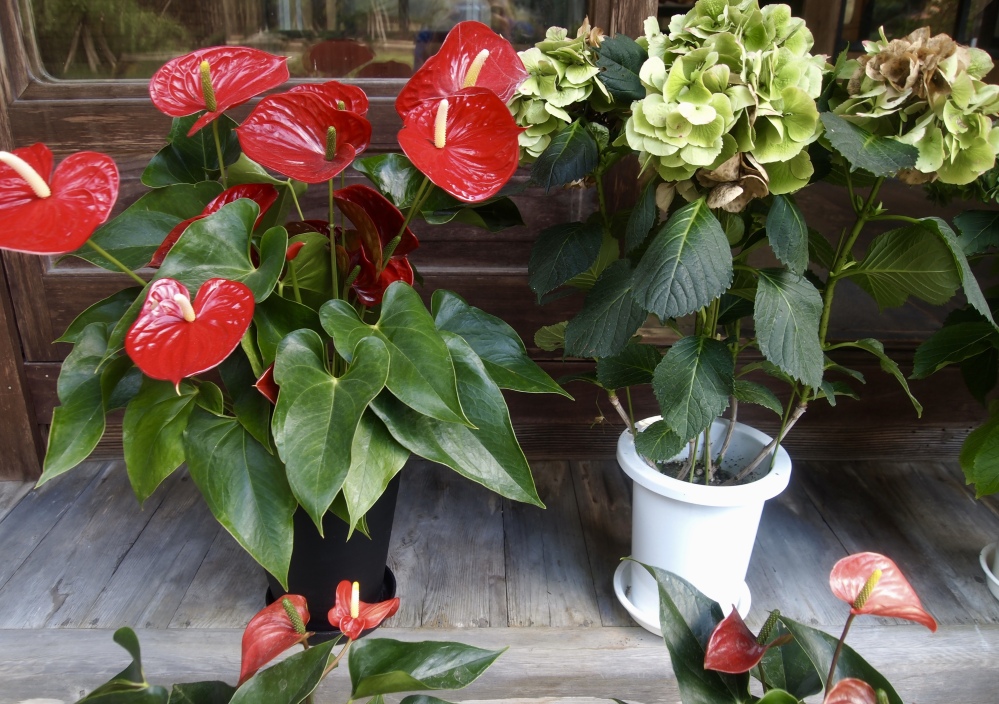
flower pots on the steps of Kongo Sanmaiin

pagoda at Kongo Sanmaiin

pagoda at Kongo Sanmaiin

pagoda at Kongo Sanmaiin
After my stroll around the grounds, I buy a beer from a vending machine and relax in my room while waiting for dinner. I had been wondering if alcoholic beverages would be served in a temple, so I’m pleasantly surprised to find several vending machines offering an array of choices.
At dinnertime, I join the other guests in a communal tatami matted room, where we’re served a Buddhist vegetarian meal or shojin-ryori. I enjoy tempura vegetables, miso soup, seaweed, beans, steamed vegetables, hot noodles, tofu, rice and mushrooms, all artistically presented. For dessert, watermelon and kiwi.
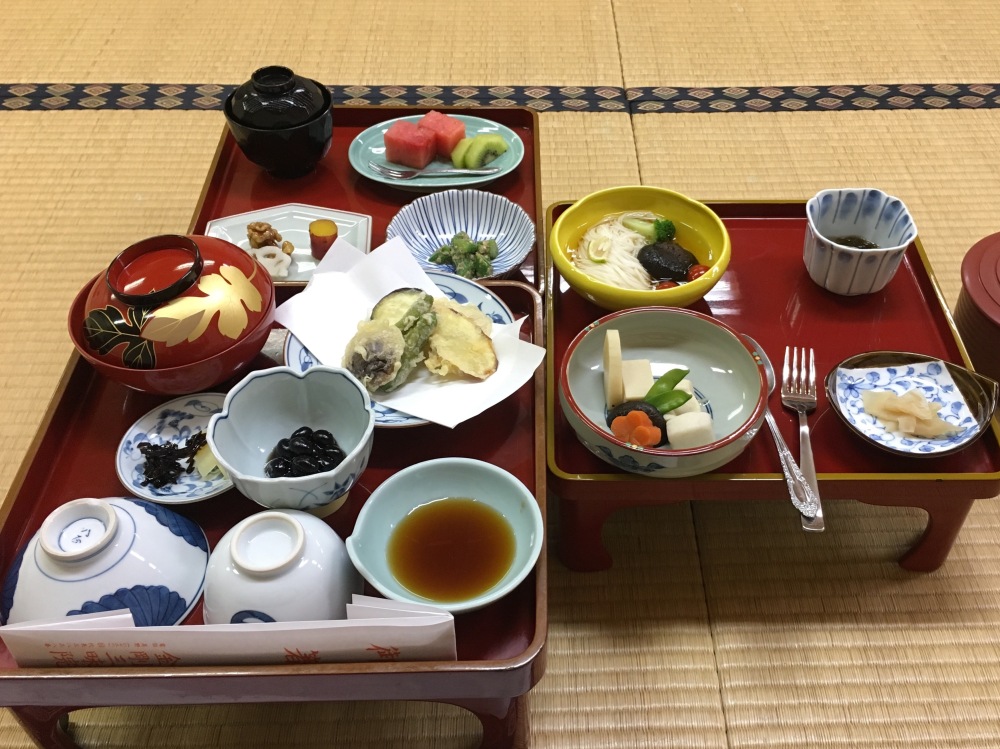
vegetarian meal at Kongo Sanmaiin
After dinner, I take an evening walk in Koyasan. The streets are pretty deserted at this hour.

temple in Koyasan

holy figure

holy figure

pagoda in Koyasan

elephant at the pagoda

lantern and deserted streets of Koyasan

hydrangeas on the walk

sunset at Koyasan
Later, I enjoy the communal onsen, or Japanese bath, and then go to sleep early. In the morning, I’ll awake before daybreak to attend the Buddhist Sunday morning ceremony.
Total steps today: 14,804 (6.27 miles).

































































































































































































































































